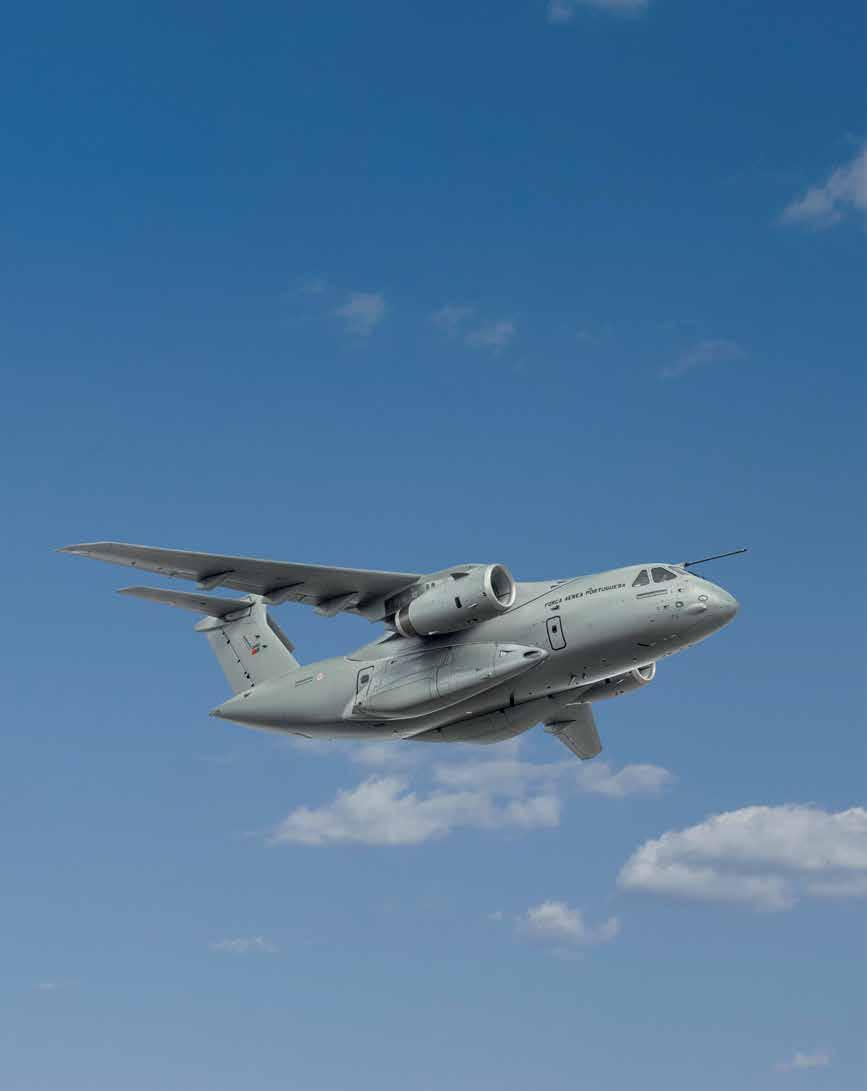

VOL 27 ISSUE 4 • 2024 aviation BA RNI NUMBER: DELENG/2008/24199 THE INDISPENSABLE INDUSTRY PAGE 14 EXCLUSIVE AIR MARSHAL ASHUTOSH DIXIT, DEPUTY CHIEF OF THE AIR STAFF, INDIAN AIR FORCE MILITARY IAF PARTNERING EMBRAER DEFENSE ARUN KASHYAP (EX-COO OF SPICEJET) LAUNCHES AIR CHARTER BUSINESS 1 st & EXCLUSIVE & MUCH MORE...



SP’S MILITARY YEARBOOK 2021-2022 CONTENTS HEREWITH ALL NEW - SP’S MILITARY YEARBOOK 21-2022 • AN INDISPENSABLE REFERENCE DOCUMENT * MOST UPDATED INDIA’S WHO’S WHO IN DEFENCE, MOST UPDATED ASIA’S WHO’S WHO IN DEFENCE & MUCH MORE.... SP’s Military Yearbook 2021 –2022 GET YOUR COPIES, NOW: E-mail us at order@spsmilitaryyearbook.com WhatsApp us at +91 97119 33343 Call us on +91 11 24644693, 24644763, 24658322 Connect via : @SPsMYB www.spsmilitaryyearbook.com
Anil Chopra (Retd) Group
Joseph Noronha (Retd) Europe: Alan Peaford
USA & Canada: LeRoy Cook
CHAIRMAN & MANAGING DIRECTOR
Jayant Baranwal
PLANNING & BUSINESS DEVELOPMENT
Executive Vice President: Rohit Goel
MANAGER – HR & ADMIN
Bharti Sharma
DEPUTY MANAGER – CIRCULATION
Rimpy Nischal
GROUP RESEARCH ASSOCIATE
Survi Massey
RESEARCH ASSISTANT
Sarthak Baranwal
DESIGN
Holistic Directions: Jayant Baranwal
Sr. Designer: Vimlesh Kumar Yadav, Designer: Sonu Bisht
GROUP DIRECTOR – SALES & MARKETING
Neetu Dhulia
DIRECTOR – SALES
Rajeev Chugh
SP’S WEBSITES
Sr Web Developer: Shailendra Prakash Ashish
Web Developer: Ugrashen Vishwakarma
© SP Guide Publications, 2024
Subscription/Circulation
Annual Inland: `1,200 • Foreign: US$320
E-mail: subscribe@spguidepublications.com subscribe@sps-aviation.com
LETTER TO EDITOR editor@sps-aviation.com; expert@sps-aviation.com
For Advertising details, contact: neetu@spguidepublications.com rajeev.chugh@spguidepublications.com
SP GUIDE PUBLICATIONS PVT LTD
A-133 Arjun Nagar, (Opposite Defence Colony) New Delhi 110003, India.
Tel: +91 (11) 24644693, 24644763, 24658322
Fax: +91 (11) 24647093
E-mail: info@spguidepublications.com
Representative Office
MOSCOW, RUSSIA LAGUK Co., Ltd., (Yuri Laskin) Krasnokholmskaya, Nab. 11/15, app. 132, Moscow 115172, Russia.
Tel: +7 (495) 911 2762
Fax: +7 (495) 912 1260


India’s Air Force VIP Squadron, using Embraer Legacy aircraft, is a perfect example of the important role that Business Aviation (BA) plays in economy and governance. Thus, Government support is crucial to harness the economic and social benefits of business aviation. (Cover
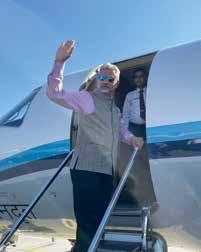
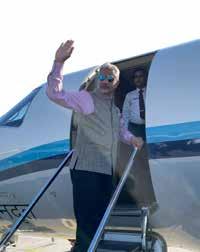

1 ISSUE 4 • 2024 www.sps-aviation.com SPACE 3 ISRO Another Success with the Autonomous Landing Experiment MILITARY EXCLUSIVE 6 DCAS Interview Air Marshal Ashutosh Dixit, Deputy Chief of the Air Staff 11 Partnership IAF Partnering Embraer Defense BUSINESS AVIATION 14 Industry A Catalyst for Economic Growth 18 Technology Redefining Comfort in Business Jets 1st & EXCLUSIVE 22 Interview Arun Kashyap, Promoter and CEO of Sirius India Airlines TECHNOLOGY 24 IAF Indian Air Force Pushing Boundaries INDUSTRY 27 IAI IAI Launches AeroSpace Services India ENGINES 29 Technology Powering the Future REGULAR DEPARTMENTS 2 From Editor-in-Chief 31 Hall of Fame Aérospatiale/BAC Concorde: Racing the Sun 32 NewsDigest COVER IMAGE
COVER DESIGN BY: SP’s Team NEXT ISSUE: New Military Technologies TABLE OF CONTENTS VOL 27 ISSUE 4 • 2024 PUBLISHER AND EDITOR-IN-CHIEF
Baranwal
MANAGING EDITOR Neetu Dhulia
Ayushee Chaudhary CONTRIBUTORS
Air Marshal
Photo: DrSJaishankar / X)
Jayant
DEPUTY
PRINCIPAL CORRESPONDENT
India:
Captain
/ PARTNER OF WWW.SPGUIDEPUBLICATIONS.COM Awards 2017 SPECIAL CONTRIBUTION TO BUSINESS AVIATION VOL 27 ISSUE 4 2024 aviation BA RNI NUMBER: DELENG/2008/24199 THE INDISPENSABLE INDUSTRY PAGE 14 EXCLUSIVE AIR MARSHAL ASHUTOSH DIXIT, DEPUTY CHIEF OF THE AIR STAFF, INDIAN AIR FORCE MILITARY IAF PARTNERING EMBRAER DEFENSE ARUN KASHYAP (EX-COO OF SPICEJET) LAUNCHES AIR CHARTER BUSINESS 1st & EXCLUSIVE & MUCH MORE...
MEMBER
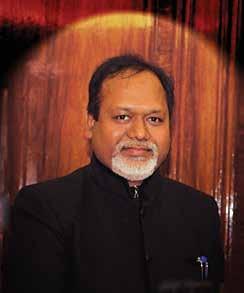
It is in this context, that we also turn our attention to the realm of business travel in this issue, with a feature by Swaati Ketkar on how BA/GA can be a catalyst for economic growth and by acknowledging the economic and social advantages of business aviation and enacting supportive policies, governments can cultivate an environment conducive to growth and bolster the overall economy.
New technology and innovation are constantly transforming business jets into luxurious havens, prioritising comfort and productivity for the modern executive. Rohit Goel looks at some of the most popular business jets in their category and how they are leveraging technology to offer the ultimate flying experience to their travellers.
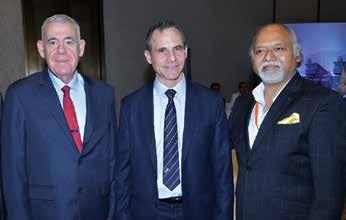
The cover of this issue highlights two significant points regarding Business Aviation (BA) in India. BA industry is quite crucial for the economic growth and that it plays a considerable role in governance by providing mobility of top dignitaries of the government. This industry quietly demands the support of the government to be able to contribute much more.
The recent launch of Sirius India Airlines promises enhanced accessibility and luxury in the realm of private air travel. In a First & Exclusive interview with Swaati Ketkar, Promoter and CEO Arun Kashyap, emphasised the airline’s commitment to setting a new benchmark for private charter travel in India and beyond.
The IAF safeguards India’s vast airspace with a powerful and diverse fleet. Ayushee Chaudhary covers Embraer aircraft as a valuable part of this mix, excelling in specific missions and demonstrating exceptional efficiency in their specialised roles.
In an exclusive interview to Manish Jha, Deputy Chief of the Air Staff Air Marshal Ashutosh Dixit, shares insights on the IAF’s capability roadmap and its focus on next-generation technology adoption. Meanwhile, the integration of Big Data Analytics and AI platforms is revolutionising air combat and decisionmaking processes within the IAF. Manish Kumar Jha delves into the groundbreaking AI applications and their potential to redefine the aerospace industry.
Lastly, we celebrate ISRO’s milestone achievement in Reusable Launch Vehicle (RLV) technology with the successful landing experiment of RLV-LEX-02. Ayushee Chaudhary provides a report on this groundbreaking feat, marking another triumph for India’s space exploration endeavors.
All this and more in this issue of SP’s Aviation. Welcome aboard and we wish you many happy landings!

2 ISSUE 4 • 2024 www.sps-aviation.com A WORD FROM EDITOR-IN-CHIEF
JAYANT BARANWAL PUBLISHER & EDITOR-IN-CHIEF FOLLOW US ON Owned, published and printed by Jayant Baranwal, printed at Kala Jyothi Process Pvt Ltd and published at A-133, Arjun Nagar (Opposite Defence Colony), New Delhi 110003, India. All rights reserved. No part of this publication may be reproduced, stored in a retrieval system, or transmitted in any form or by any means, photocopying, recording, electronic, or otherwise without prior written permission of the Publishers. SPPublications @SPsAviation
THE LAUNCH OF AEROSPACE SERVICES INDIA (ASI), A SUBSIDIARY, WAS A LANDMARK EVENT FOR ISRAEL AEROSPACE INDUSTRIES (IAI). ON THE OCCASION, JAYANT BARANWAL, CHAIRMAN AND MANAGING DIRECTOR, SP GUIDE PUBLICATIONS MET WITH (LEFT) BOAZ LEVY, PRESIDENT AND CEO OF IAI AND (CENTRE) ZEEV MIVTZARI, IAI INDIA COUNTRY HEAD & CHIEF MANAGING DIRECTOR.
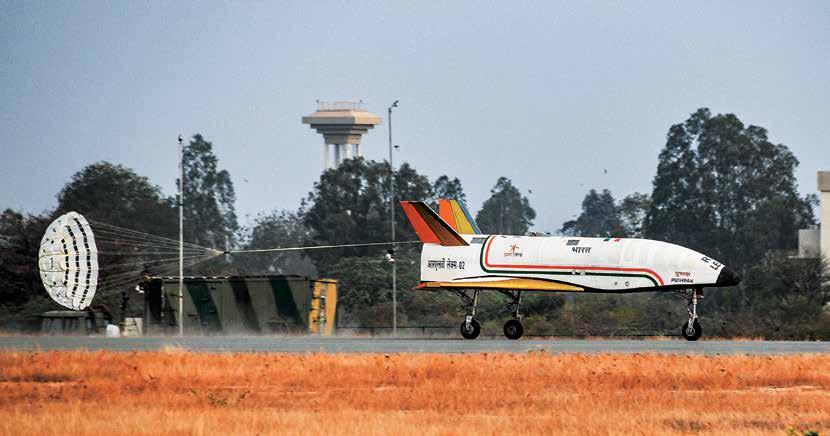
ANOTHER SUCCESS WITH THE AUTONOMOUS LANDING EXPERIMENT
ISRO achieved a major milestone in the area of Reusable Launch Vehicle (RLV) technology, through the RLV LEX-02 landing experiment, the second of the series
By AYUSHEE CHAUDHARY
Pushpak (RLV-TD), ISRO’s winged vehicle, landed autonomously with precision on the runway after being released from an off-nominal position, adding another feather to ISRO’s hat of success. ISRO achieved a major milestone in the area of Reusable launch vehicle (RLV) technology, through the RLV LEX-02 landing experiment, the second of the series, conducted at Aeronautical Test Range (ATR), Chitradurga in
Karnataka on March 22. After the RLV-LEX-01 mission was accomplished last year, RLV-LEX-02 demonstrated the autonomous landing capability of RLV from off-nominal initial conditions at release from Helicopter. The RLV was made to undertake more difficult maneuvers with dispersions, correct both cross-range and down-range and land on the runway in a fully autonomous mode.
3 ISSUE 4 • 2024 www.sps-aviation.com SPACE ISRO
PHOTOGRAPH:
PUSHPAK (RLV-TD), THE WINGED VEHICLE, LANDED AUTONOMOUSLY WITH PRECISION ON THE RUNWAY AFTER BEING RELEASED FROM AN OFF-NOMINAL POSITION
ISRO
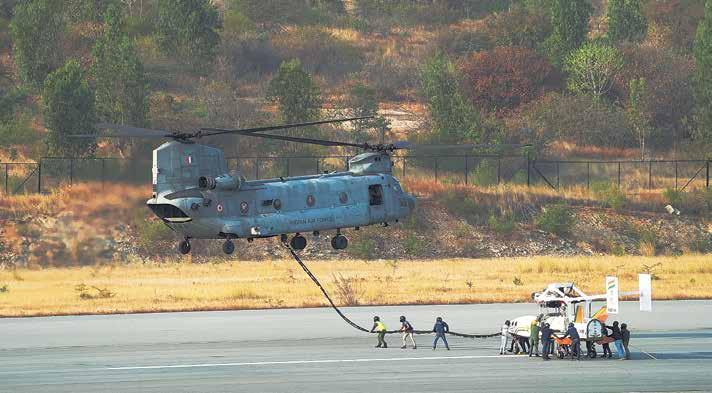
The winged vehicle, named Pushpak, was lifted by an Indian Air Force (IAF) Chinook helicopter and was released from 4.5 km altitude. After release at a distance of 4 km from the runway, Pushpak autonomously approached the runway along with cross-range corrections. It landed precisely on the runway and came to a halt using its brake parachute, landing gear brakes and nose wheel steering system.
The mission was accomplished by Vikram Sarabhai Space Centre (VSSC) along with the Liquid Propulsion System Centre (LPSC) and the ISRO Inertial Systems Unit (IISU). Collaboration from various agencies including IAF, ADE, ADRDE and CEMILAC contributed to the success of this mission. S. Somanath, Chairman, ISRO Secretary, DOS, congratulated the team for the flawless execution of this complex mission. On the success of the landing experiment, Director VSSC Dr S. Unnikrishnan Nair mentioned that through this repeated success, ISRO could master the terminal phase maneuvering, landing and energy management in a fully autonomous mode, which is a critical step towards the future Orbital Re-entry missions.
PIONEERING AUTONOMY IN SPACE EXPLORATION
This mission successfully simulated the approach and highspeed landing conditions of RLV returning from space. With this second mission, ISRO has re-validated the indigenously developed technologies in the areas of navigation, control systems, landing gear and deceleration systems essential for performing a high-speed autonomous landing of a space- returning vehicle. The winged body and all flight systems used in RLV-LEX-01 were reused in the RLV-LEX-02 mission after due certification/clearances. Hence this mission also demonstrated the reuse capability of flight hardware and flight systems. Based on the observations from RLV-LEX-01, the airframe
structure and landing gear were strengthened to tolerate higher landing loads.
ISRO had successfully conducted the RLV Autonomous Landing Mission (RLV LEX-01) at the ATR, Chitradurga on April 2, 2023. The RLV was taken off by IAF’s Chinook Helicopter as an underslung load and flew to a height of 4.5 km (above MSL). Once the predetermined pillbox parameters were attained, based on the RLV’s Mission Management Computer command, the RLV was released in mid-air, at a down range of 4.6 km. Release conditions included 10 parameters covering position, velocity, altitude and body rates, etc. The release of RLV was autonomous. RLV then performed approach and landing maneuvers using the Integrated Navigation, Guidance & control system and completed an autonomous landing on the ATR air strip. With that, ISRO had successfully achieved the autonomous landing of a space vehicle.
The autonomous landing was carried out under the exact conditions of a Space Re-entry vehicle’s landing-high speed, unmanned, precise landing from the same return path as if the vehicle arrived from space. Landing parameters such as ground relative velocity, the sink rate of landing gears, and precise body rates, as might be experienced by an orbital re-entry space vehicle in its return path, were achieved. The RLV LEX demanded several state-of-the-art technologies including accurate Navigation hardware and software, Pseudolite system, Kaband Radar Altimeter, NavIC receiver, indigenous Landing Gear, Aerofoil honey-comb fins and brake parachute system.
In a first in the world, a winged body had been carried to an altitude of 4.5 km by a helicopter and released for carrying out an autonomous landing on a runway. RLV is essentially a space plane with a low lift to drag ratio requiring an approach at high glide angles that necessitates a landing at high velocities of 350 kmph. LEX utilised several indigenous systems. Localised
4 ISSUE 4 • 2024 www.sps-aviation.com
ISRO
SPACE
ISRO USED AN IAF CHINOOK HELICOPTER FOR THE AIRLIFT AND SUBSEQUENT POSITIONING AT A PREDEFINED ALTITUDE AND LOCATION
/ X
PHOTOGRAPH: IAF_MCC
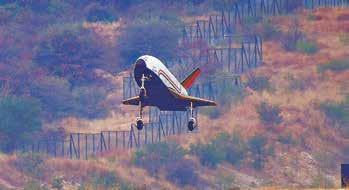
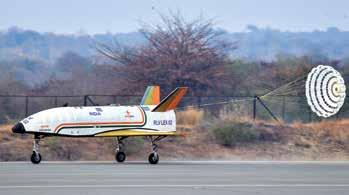
Navigation systems based on pseudolite systems, instrumentation, and sensor systems, etc were developed by ISRO. Digital Elevation Model (DEM) of the landing site with a Ka-band Radar Altimeter provided accurate altitude information. Extensive wind tunnel tests and CFD simulations enabled aerodynamic characterisation of RLV prior to the flight. Adaptation of contemporary technologies developed for RLV LEX makes other operational launch vehicles of ISRO more cost-effective.
Reusable Launch Vehicle – Technology Demonstrator (RLVTD) is touted to be one of the most technologically challenging endeavors of ISRO towards developing essential technologies for a fully reusable launch vehicle to enable low cost access to space. The configuration of RLV-TD is similar to that of an aircraft and combines the complexity of both launch vehicles and aircraft. The winged RLV-TD has been configured to act as a flying test bed to evaluate various technologies, namely, hypersonic flight, autonomous landing and powered cruise flight. In future, this vehicle will be scaled up to become the first stage of India’s reusable two stage orbital launch vehicle.
RLV-TD consists of a fuselage (body), a nose cap, double delta wings and twin vertical tails. It also features symmetrically placed active control surfaces called Elevons and Rudder.
OBJECTIVES OF RLV-TD
l Hypersonic aero thermodynamic characterisation of wing body
l Evaluation of autonomous Navigation, Guidance and Control (NGC) schemes
l Integrated flight management
l Thermal Protection System Evaluation

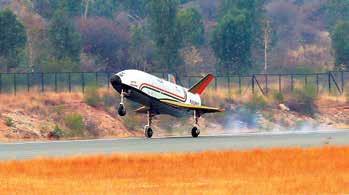
This technology demonstrator was boosted to Mach no: 5 by a conventional solid booster (HS9) designed for low burn rate. The selection of materials like special alloys, composites and insulation materials for developing an RLV-TD and the crafting of its parts is very complex and demands highly skilled manpower. Many high technology machinery and test equipment were utilised for building this vehicle.
RLV-TD was successfully flight tested on May 23, 2016 from SDSC SHAR Sriharikota validating the critical technologies such as autonomous navigation, guidance & control, reusable thermal protection system and re-entry mission management.
REUSABILITY FOR THE FUTURE
In the pursuit of cost-effective space exploration, the concept of reusable landing vehicles has emerged as a solution to recover pricey rocket boosters utilised in spacecraft launches. These vehicles can be refurbished and reused for subsequent space flights, offering significant cost savings. Key components targeted for reuse include rocket stages, engines, and boosters, effectively reducing the overall expense of launches.
Equipped with added protective measures such as heat shields and grid fins, these reusable vehicles weigh more than their expendable counterparts due to the inclusion of additional avionics and propellant. The design of the spaceplane is also adapted to facilitate the recovery process.
Typically, launch vehicles consist of multiple stages to propel payloads into specific orbits. However, the RLV features only two stages. Once the fuel in the first stage is depleted, it is jettisoned, and the vehicle continues its journey using the second stage. The first stage then autonomously re-enters the atmosphere and lands at a predetermined location, ready for maintenance and future reuse. SP
5 ISSUE 4 • 2024 www.sps-aviation.com
ISRO
SPACE
(CLOCKWISE FROM TOP LEFT) REUSABLE LAUNCH VEHICLE (RLV) ‘PUSHPAK’ CAPTURED DURING ITS AUTONOMOUS LANDING
PHOTOGRAPHS: ISRO

“AI WILL IMPROVE OUR OPERATIONAL EFFICIENCY MANY TIMES MORE”
In an exclusive interview, Air Marshal Ashutosh Dixit, Deputy Chief of the Air Staff speaks with Manish Kumar Jha for SP’s Aviation, on the IAF’s capabilityroadmap and the thrust on the next-generation technology adoption
6 ISSUE 4 • 2024 www.sps-aviation.com MILITARY DCAS INTERVIEW
EXCLUSIVE PHOTOGRAPH: NDIAN AIR FORCE
DEPUTY CHIEF OF THE AIR STAFF AIR MARSHAL ASHUTOSH DIXIT
MILITARY DCAS INTERVIEW
With combat flying experience on fighter, trainer and transport aircraft and having commanded a frontline fighter base in the Western sector, as well as a premier fighter training base, Air Marshal Dixit is well placed to lead the critical and complex capability plan of the IAF. During the comprehensive interaction, Air Marshal Dixit outlines the plans for the frontline combat jet programme and the acquisition of advanced UAVs among others. Excerpts:
Manish Kumar Jha (Jha): Do you see LCA Tejas as the front-line combat jet?
Air Marshal Ashutosh Dixit (Dixit): The IAF concluded Vayu Shakti. We demonstrated Tejas where LCA Tejas performed an air-to-ground attack and immediately after that air to air. So, this is the concept of a front-line fighter jet that can do any mission at any time. So, we have built a capability which is for the front-line fighter aircraft. And, we are very happy as again Mk1A flew recently. They will fly the first flight and then this year we are going to make the squadron.
Jha: So, when you say it’s a front line, would you also talk about the combat capabilitythe weapon part of how Tejas is going to be a lethal combat jet?
Dixit: There are 3-4 types of categories of weapons. One is the beyond visual range (BVR). We have our own ASTRA which we will be firing from LCA in April. Then we have air to ground and weapons of different types. We have some 10 different types of weapons that Tejas can fire. There are normal bombs and up to 1,000 pounds of bombs. It can also fire Laser-guided bombs and it can also fire long-range special weapons. So, I think we have got a full envelope of weapons available.
Jha: How do you define MK1? While Mk2 is in the pipeline for the future and in the making, what does it mean?
the inside is very compact. It is like everything is sitting almost on top of each other so that we have sorted it out. We have cleaned up the internals. We have also modernised some LRUs as they have become slightly smaller. Like this, we have made a major effort to improve maintenance. These are the major changes in LCA Mk1A. We could do this because we learned it along the way in making Mark 1.
Now, we have to install new weapons. Also, Astra is fired successfully. From here, we are going from MK1 to MK2. Now, we are going to implement 3-4 major technological changes. Firstly, the size of the aircraft will be bigger. So, first is the weaponcarrying capacity and it will take more load. It will go further. It will be able to remain in the air for a longer period. Then we are putting canards to improve the manoeuvrability of the aircraft. In fact, LCA Mk1A is also quite manoeuvrable. Most of the modern fighters have canards.
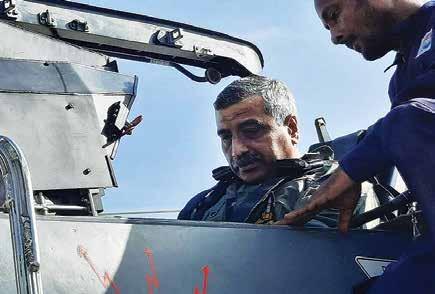
Dixit: Mark 1—IOC & FOC—now, we have built the basic. From there, we graduated to LCA Mk1A. So, in Mark 1A, we introduced 4 major changes which are our learning curve. We incorporated the Active Electronically Scanned Array Radar (AESA). Then we have got integral EW suite. The most important thing which we have done, which is not visible, is that we have enhanced the maintainability of the platform. It is by one order of magnitude that we have improved it. While you cannot see it from outside because from outside the aircraft looks the same it is the inside of the aircraft which has been laid out neatly and the accessibility of the components and how they are being changed.
Jha: So, is it about the increased life cycle of the aircraft and also the reduced cost of Maintenance?
Dixit: Suppose I take 1 hour to prepare an earlier version, I will take only 15 minutes to repair this version. So, I can do a greater number of sorties/missions and it’s very easy to maintain and ready for operation.
Jha: How do you increase that efficiency?
Dixit: Yes, that is how we have done. So, a fighter aircraft from
Jha: Is Tejas Mk2 also about multi-role combat jets?
Dixit: Tejas is designed to be very agile agility and that is why we want to put canards. We are building a mechanism to improve the pilot interface. In the cockpit, we are putting a side stick so that in front, we can put one big slot. So, a lot of space is available for displaying information because now you see, the information is increasing. The amount of information which is coming in poses challenges as to how you can process the whole decision-making while analysing such a vast amount of digital data in the combat zone. Now, it will be easier for the pilot.
But the major achievement which we want to do is the sensor fusion. So, we are getting information from radar, from EW Suite and some other aircraft. Earlier, all such information was delivered to the pilot separately and a pilot had to look into the pilot grid. The information is so vast and it comes so rapidly that it becomes a major challenge for the pilot to handle it. So, it is done by a method called Sensor Fusion. This technology [Sensor Fusion], we want to put in the next version of LCA.
7 ISSUE 4 • 2024 www.sps-aviation.com
PHOTOGRAPH: NDIAN AIR FORCE
DEPUTY CHIEF OF THE AIR STAFF AIR MARSHAL ASHUTOSH DIXIT FLYING LCA TEJAS
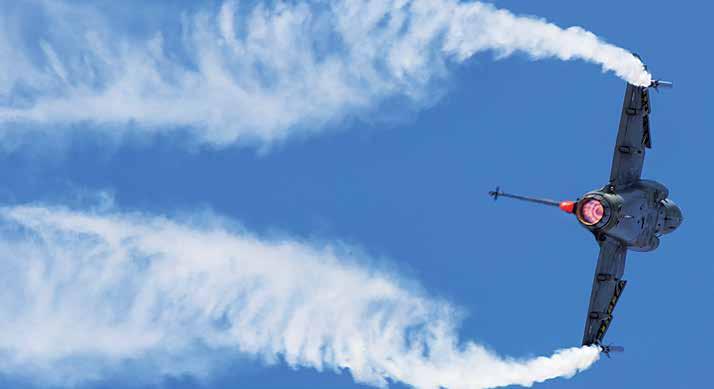
Jha: Based on such tech-advancement can a pilot in the cockpit decide on his own based on the data rather than from the ground station?
Dixit: Decision-making will be much faster and the quality of the decision will be much better. Earlier you used to look at five different places, now, he will only look at one or two places and he will be able to make a decision, whether I have to shoot this target or which is the best way to enter the enemy’s territory.
Jha: The combat jet has many defined roles, as fighter jets will perform in certain combat requirements. Is it about aerospace superiority or a multi-role fighter jet? How would you like to define it in such a context?
Dixit: Nowadays, such definitions and roles have become fuzzy—as they are multi-dimensional. So, what we call it is swing role capability. Earlier, if you remember, it was called a fighter aircraft or an attack aircraft. Like an F-16 or F-18, later it was called F/A-18. Today, we combine all possible roles of a fighter aircraft. Aircraft capabilities have increased radically. Earlier, a pilot was also a limiting factor. He had to prepare for so many roles, but now because of this AI and this Sensor Fusion integration, a pilot can also perform multiple roles. It’s a kind of a force-enhancer.
So, all the roles for a fighter aircraft are possible whether it is an armrecce, an area denial, or an air defence ground attack.
Jha: In the combat zone, can LCA Tejas go on their own rather than in the support formation?
Dixit: Yes, absolutely. Of course, there will be support from AWACS as they are supporting other jets. We go in a formation of similar aircraft.
Jha: Since Mark 1A is still in progress, is the talk of Tejas Mk2 still too early because there have to be various elements which include design, engine parts and a lot of things, and frame-wise, it’s bigger and requires a new approach?
Dixit: So now you have to look at it from a different way as to how many aircraft is HAL able to produce. So, this year, they can produce 16 aircraft. Next year, it will be 24 so 24 aircraft. We have ordered 83. We have again ordered 97 and we will order more. So, by 2031-32, they will complete this function.
“We are embarking on another very prestigious product project--IMRH. For IMRH, we will have our indigenous engine under the JV between Safran and HAL. And it is being designed and it will be manufactured in India.”
So, when in 2032, they finish the production of Mark 1A, we should be commencing the production of Mk2. So, within 8 years, we have to develop the aircraft and produce it.
In fact, for LCA Mk2, we have already completed CDR and metal cutting is about to start next quarter. I think within one and a half to 2 years, we will be able to progress significantly. Then we have to do testing which is the most important. So, we are on time. The cut-off point is the delivery of Mk1A.
8 ISSUE 4 • 2024 www.sps-aviation.com MILITARY DCAS INTERVIEW
LCA TEJAS MK2 IS ON TIME WITH PRODUCTION EXPECTED TO BEGIN IN 2032
PHOTOGRAPH: SP GUIDE PUBNS

Jha: What about stealth technology for Tejas 2?
Dixit: Stealth is for AMCA.
Jha: Could you please tell us how is AMCA unfolding? Where do you put AMCA in your capability plan?
Dixit: AMCA is indeed a futuristic aircraft. We have completed the CDR. We know the technologies which we need to develop. Now the approval has also been granted.
Jha: There is a global trend as we see international collaboration for the next generation of fighter jets which is being adopted by many advanced countries like the UK, the US, Japan, Korea, and others. Is it about the flow of the technology that India should adopt or should we go on developing on our strength? How do you think we should be able to produce next-gen aircraft, keeping the scale of the cost and technology?
Dixit: India has a unique place in the world and our need is different. We need indigenous capability and technology is required. We have our problems and our threat perception. We will continue to go along this path.
Jha: While this has been addressed by the Indian Air Force recently, there’s a genuine understanding of the fact that since Russia is already busy supplying its operational requirements, is the IAF facing any challenges in terms of spare parts and upgradation—for example, Su-30 MKI?
Dixit: We are already embarking on an
upgrade of the project. For Sukhoi, we have been able to do 60-75 per cent of the indigenisation. When the project is over successfully, we should be close to 90 per cent of localisation.
And simultaneously, not only the aircraft, we are trying to address the engine - upgrade on our own. We are trying to design Special Metals as Special Alloys. Then we will reach 95 per cent of indigenisation for Su-30 MKI. So, I think, we will be in a very good position next five to seven years. However, right now, we have to wait that long and we have to take interim measures that we are taking.
Jha: In your capability plan, next comes the unmanned aerial systems. How do you prioritise it and what’s the plan for having an advanced level MALE and HALE category of UAVs? And, how much time will it take to have such a capability?
Dixit: I think the renewed focus is there. Need our own sensors, we will be able to do air vehicle. The air vehicle is the airframe. Sensors are the Key part. So, even if the air vehicle is there, the sensor has to be able to look deep into the required territory and listen also.
“I think the renewed focus on unmanned aerial systems is there. Need our own sensors, we will be able to do air vehicle. Sensors are the key part.”
Jha: DRDO’s Tapas has been progressing, however, it has been taken off the mission mode. What is required here?
Dixit: We have to do indigenous production and we are on it. However, we will be able to overcome some shortcomings and some design deficiencies to improve upon. We are users. In the end, I will be able to see how it can serve my needs or my operational requirements.
9 ISSUE 4 • 2024 www.sps-aviation.com MILITARY DCAS INTERVIEW
AMCA WILL BE A FUTURISTIC AIRCRAFT WITH STEALTH TECHNOLOGY
PHOTOGRAPH: FLYINGDAGGERS45SQUADRON / WIKIPEDIA
So, I cannot comment on design or something. Endurance is being worked out.
We are open to such development, exploring the market and encouraging the Private sector also to take part in this kind of project. I hope we will be doing something within the next six months. We will go to the government and ask for approval then.
Jha: Could you talk about the progress on indigenous helicopters?
Dixit: We have supported ALH since the beginning. We inducted ALH Mark1 in the IAF. We are displaying and flying it all over the world. Sarang is ALH Mk1. Recently it performed very well in Singapore. Then we inducted Mark 3 in good numbers and the armed version — Mark 4 Rudra which we also inducted.
As we see Mark 4 is shaping up correctly, we further improved it; instead of making it side by side, we made it tandem. So that it will become a proper combat helicopter. We have been constantly guiding HAL in the endeavour. We have already been inducted in Jodhpur. We are going to give more orders for a very large number—one of the largest for the indigenous platforms. Further, we will soon induct LUH where the Army is the lead service. LCH is the only helicopter in the world which can take off from 6,000 ft and fire weapons at such altitude. We held hands with HAL throughout.
Now we are embarking on another very prestigious product project—Indian Multirole Helicopter (IMRH). This is the replacement for the Mi-17 series. They will be there with us for about 10 to 12 more years after that we will start phasing out. We are in deep discussions with the HAL on IMRH. We are supporting them. For IMRH, we will have our indigenous engine under the JV between Safran and HAL. And it is being designed and it will be manufactured in India.
Jha: Will we be able to possibly export in the future because we’ll have full control and IPs over this?
AI helps to focus on which area to continuously improve my operational potential. There are so many other things in the Air Force which are happening. This also requires training on the model, feeding the past data and doing some kind of test, so we are doing that.
How do we look at AI? For each person, if the output is increased by 10 per cent, because of the use of AI then as a whole, the Air Force will become 10 per cent better with existing resources. So, this is a day-to-day work. Then AI is getting into the war-fighting domain. During peace time we keep collecting information on adversaries or from all possible sources. That is the analysis and intent generation.
Second, it is also about using weapons. Aircraft, helicopters, and missiles. So, we are working like LCA Mark 2 and AMCA which will have major support to pilot through AI and that project is also launched. It covers maintenance and production. AI will improve our operational efficiency many times more.
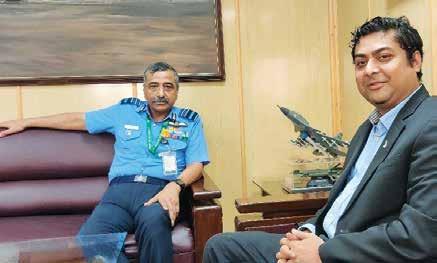
Dixit: Yes, that is the plan. Because there are very few in the world who are making helicopters of this variety. It will be required in a large part. With HAL, this is another major project we are embarking on.
Jha: Along, C295 has been progressing. Does it fulfil all the criteria for military logistics?
Dixit: It is a project for the Avro replacement. It fulfils all the criteria of the Avro replacement which is in the class of 5-7 tonnes. Now we will be looking at capabilities for some 20-25 tonnes.
Jha: What does the AI hub do in the Indian Air Force? How will you drive it? Is it about industry collaboration? It is about just bringing technology from outside or just because you know, having your qualitative requirements being set?
Dixit: AI is a very vast field so we are doing at multiple levels. What we have done for our day-to-day running and how we operate day to day, we have set up an AI Centre of Excellence. We have done a lot of brainstorming over a large number of cases. For example, what is my training status and what is my maintenance status? What is my Log sheet status? So, can AI guide me?
Jha: Since so many developments are taking place and then you also require funds for that. I’m talking about the major fighter jet indigenous programmes which also include the MRFA programme. Should we continue with MRFA with the two major programmes TEJAS and AMCA?
Dixit: We should continue with MRFA. See for any major project, the money gets distributed over the years. So, we plan to do fund management in such a manner that these requirements can do so.
Jha: Would you go for MRFA for numbers as we need to address depleting squadron strength or because of the superior technology?
Dixit: Technologies are slightly better than what we are going to have for LCA Mk2 or somewhere close to that but we need numbers also. So, we need technology but we need the numbers also. Both are equally important. SP
Manish Kumar Jha is a Consulting & Contributing Defence Editor for SP’s Aviation, SP’s Land Forces and SP’s Naval Forces and a security expert. He writes on national security, military technology, strategic affairs & policies.
10 ISSUE 4 • 2024 www.sps-aviation.com
MILITARY DCAS INTERVIEW
PHOTOGRAPH: NDIAN AIR FORCE
DEPUTY CHIEF OF THE AIR STAFF AIR MARSHAL ASHUTOSH DIXIT IN CONVERSATION WITH THE AUTHOR MANISH JHA

EMBRAER LEGACY BUSINESS JETS OF THE IAF COMMUNICATION SQUADRON ARE DEDICATED TO FACILITATING AIR TRANSPORTATION FOR A WIDE SPECTRUM OF VVIPS, VIPS AND ESTEEMED DIGNITARIES
IAF PARTNERING EMBRAER DEFENSE
With their versatility, operational efficiency, and technological advancements, Embraer aircraft have become a trusted component of the IAF’s aerial arsenal
By AYUSHEE CHAUDHARY
The Indian Air Force stands as a formidable guardian of the nation’s airspace, equipped with a diverse array of aircraft crucial for ensuring national security. Among these aircraft, the Embraer fleet has emerged as a key component, fulfilling specialised roles with exceptional efficiency. The IAF boasts a diverse and powerful fleet of aircraft, crucial for safeguarding India’s vast airspace. Among these, Embraer aircraft have carved a niche for themselves, fulfilling specific roles and missions with remarkable efficiency.
Currently, the Indian Air Force (IAF) possesses a collection of five airborne surveillance platforms. These include two domestically developed Netra MK-1 AEW&CS systems installed on Brazilian Embraer ERJ-145 platforms, as well as three Airborne Warning and Control System units featuring Israeli-Phalcon systems, installed on Russian IL-76 cargo aircraft. This varied and sophisticated fleet guarantees extensive coverage and adaptability in diverse operational situations.
The Brazilian aerospace manufacturer Embraer’s
11 ISSUE 4 • 2024 www.sps-aviation.com MILITARY PARTNERSHIP
PHOTOGRAPH: PIB
MILITARY PARTNERSHIP
well-known portfolio encompasses commercial jets, executive jets, military aircraft, and agricultural aircraft placing it among the top largest commercial aircraft manufacturers, highlighting its prowess in the aviation industry. In the defence sector, Embraer has supplied eight jets to India for VVIP travel and use as airborne early warning and control (AEW&C) aircraft.
Embraer aircraft have become a trusted component of the IAF’s aerial arsenal. Their versatility, operational efficiency, and technological advancements make them valuable assets for the Indian defence establishment. As India continues to modernise its air force, Embraer is likely to continue playing a significant role in the future, providing the IAF with the necessary tools to safeguard the nation’s skies.
As India continues its journey of air force modernisation, Embraer has been crucial in helping it achieve the same and is further poised to maintain a significant role, providing the IAF with the cutting-edge tools necessary to safeguard the nation’s skies. Here’s a closer look at the journey and advancements of these modernisation instruments:
NETRA
India had embarked on a significant technological endeavor with the acquisition of its first Embraer 145 Airborne Early Warning and Control Aircraft (AEW&C), better known as “Netra” (Networking TRaffic Analysis). This milestone marked a substantial advancement in the nation’s quest to establish a robust airborne surveillance and detection system, amplifying its defence capabilities.
The journey of India’s AEW&C evolution traces back to 1985 with the establishment of the Airborne Surveillance, Warning, and Control (ASWAC) Centre, which later evolved into the Centre for Airborne Systems (CABS) in 1991. Despite facing challenges, the AEW&C Programme, sanctioned in 2004, witnessed collaborative efforts between CABS, Defence Research and Development Organisation (DRDO), and various research establishments. This collaboration led to the development of three AEW&C systems installed on the Embraer-145 executive jet platform, providing net-centric capability with multiple communication data links and onboard mission control. Over time, the Netra AEW&CS initiative, led by DRDO, has developed into a vital element of the IAF’s surveillance and reconnaissance capabilities.
India’s progress in AEW&C capabilities, earning its place in the skies as a guardian of national security.
Prior to the introduction of the Netra, the IAF utilised the Embraer EMB-135BJ Legacy, a smaller model tailored for electronic warfare and intelligence-gathering assignments. These aircraft were instrumental in conducting reconnaissance and surveillance tasks, furnishing invaluable intelligence to the IAF. Although the EMB-135BJ has been retired from service, the EMB-145 Netra continues the tradition of these Embraer platforms within the IAF, ensuring the continuity of their legacy.
The IAF’s need for additional AEW&C aircraft is critical, especially amidst ongoing conflicts. The success of Netra MarkI emphasises the importance of timely maintenance and support, while the pursuit of Netra Mark-1A and Mark-2 variants demonstrates India’s commitment to enhancing airborne surveillance capabilities. Netra has proven its effectiveness during operations like Balakot and has become a cornerstone of the IAF’s Airborne Surveillance Systems.
In 2023, the IAF welcomed the third Netra AEW&CS MK1, showcasing its dedication to bolstering airborne surveillance capabilities. This underscores the importance of ongoing success, continued R&D, and strategic collaborations in advancing indigenous defence technology.
The Indian Air Force relies on a diverse fleet of aircraft, with Embraer planes playing a crucial role in fulfilling specialised roles efficiently
The IAF aims to expand its surveillance capabilities by acquiring additional Netra aircraft. Equipped with an indigenously developed AESA radar system mounted on Embraer ERJ 145 jets, these aircraft have demonstrated effectiveness in operations like Balakot in 2019. The IAF currently operates two Netra systems and is considering adding six more as part of a $1 billion initiative to enhance surveillance and tracking capabilities. The AESA radar system provides detection and tracking capabilities for various targets, allowing effective command and control of friendly forces. Moreover, the Netra can receive in-flight refueling, doubling its endurance to nine hours, while its radar system provides coverage of 240 degrees up to a range of 500 km, enabling targeting deep into enemy territory without crossing international borders.
In 2012, Embraer Defense and Security handed over the inaugural EMB 145 Airborne Early Warning and Control (AEW&C) aircraft to the Government of India during a ceremony hosted at Embraer’s headquarters in São José dos Campos, Brazil. This milestone came after the aircraft successfully passed rigorous ground and flight tests, meeting the operational benchmarks set by both Embraer and CABS of DRDO. The EMB 145 AEW&C boasts significant enhancements, including an in-flight refueling system, a notable boost in electric and cooling capacity, and a comprehensive array of structural modifications.
The inaugural indigenous AEW&C system was formally handed over to the IAF in 2017, marking a significant milestone at the Aero India Exhibition. The Netra, with its memorable debut during the 2017 Republic Day Fly Past, symbolised
The IAF plans to advocate for the addition of six new Netra Mk1A AEW&CS aircraft next year, complementing the existing fleet of three Netra Mk1s. These upgraded planes will feature an enhanced AESA radar system developed by DRDO and will be based on the Embraer ERJ 145 platform like the current fleet. The proven operational capabilities of the existing Netra Mk1 aircraft underscore the significance of this initiative. Additionally, India is planning to develop and deploy 12 more indigenous AEW&C aircraft, a joint effort between DRDO and IAF aimed at enhancing situational awareness and defending Indian airspace.
IAF’S VIP SQUADRON
The IAF commands a diverse fleet of aircraft, encompassing both fixed-wing and rotary-wing platforms, primarily dedicated to facilitating air transportation for a wide spectrum of esteemed dignitaries during official visits to India, both domestically and internationally. Catering to the needs of VVIPs and VIPs, which include the President, Vice President, Prime Minister, and foreign Heads of Government, among others, the IAF
12 ISSUE 4 • 2024 www.sps-aviation.com
MILITARY PARTNERSHIP
ensures seamless access to high-profile individuals through its Air Headquarters Communication Squadron.
Established on November 1, 1947, the Air Headquarters Communication Squadron, strategically based at Air Force Station, Palam, New Delhi, has undergone significant evolution since its inception. Initially equipped with nine Airspeed AS 10 Oxford twin-engine trainer aircraft, the squadron now boasts a modernised inventory tailored to VIP transport, including Boeing Business Jets (BBJ), Embraer Legacy Business Jets, and Mi-17 V5 helicopters, meticulously customised to meet VIP travel requirements.
The induction of Embraer Legacy Business Jets into the squadron also marked a pivotal moment in the modernisation of the IAF’s transport capabilities. Beginning on September 21, 2005, with the delivery of three aircraft, the process continued with the arrival of the fourth aircraft and an additional aircraft designated for the Border Security Force (BSF). Unlike the IAF’s fleet, the BSF’s aircraft operates under civilian registration and is piloted by civilian-licensed aviators.
Replacing the aging fleet of Hawker Siddeley HS 748 Avro twin-turboprop engine aircraft, the Embraer Legacy Business Jets were selected after a rigorous evaluation process, owing to their exceptional value proposition. Manufactured by Embraer, these jets, derivatives of the renowned Embraer Regional Jet 135, boast a sophisticated interior configuration and modern cockpit features, including Flight Management System and Global Positioning System capabilities.
Going further, given India’s diplomatic needs and increased commitments, acquiring additional Embraer VVIP aircraft is also quite imperative. The current fleet of four aircraft falls short of meeting the nation’s requirements, particularly as diplomatic engagements expand. Therefore, it is strongly recommended to consider procuring the newer long-range Embraer Legacy 650 with extended fuel tanks. Opting for aircraft from the same family will provide the necessary flexibility while ensuring consistency in pilot training and maintenance infrastructure. This strategic approach will bolster India’s aviation capabilities and support its evolving diplomatic endeavors on the global stage.
THE EFFICIENT PARTNERSHIP
Indian manufacturers to produce Embraer aircraft within India. This collaboration would enhance India’s aerospace manufacturing self-reliance, fostering job creation and technological advancements.
• Integration of Advanced Weapon Systems: As technology advances, the IAF may explore integrating new weapon systems onto Embraer platforms. This could involve equipping the Netra with advanced electronic warfare capabilities or incorporating air-to-air or air-to-ground weapons on specific variants. Embraer’s adaptable design allows for potential modifications to meet the evolving defence needs of the IAF.
Additionally, in response to the Indian Air Force’s requirement for new medium transport aircraft (MTA), Brazilian defence firm Embraer Defense and Security and the Mahindra group have recently signed a memorandum of understanding

(MoU) to collaborate on the C-390 Millennium aircraft. The IAF’s potential order for 40 to 80 MTA is anticipated to include technology transfer and the establishment of a manufacturing line in India, further promoting indigenisation efforts.
The partnership between the IAF and Embraer reflects a commitment to modernise the fleet with efficient and adaptable platforms. Looking forward, there are various avenues for further collaboration:
• Development of Indigenously Produced Embraer Aircraft: With a focus on indigenous defence capabilities, there is potential for joint ventures between Embraer and
The partnership between Embraer Defense and Security and the Indian Air Force marks a significant stride towards enhancing India’s airborne surveillance capabilities. With the successful induction of the Netra AEW&CS aircraft and plans for further expansion, the IAF is poised to bolster its defence capabilities and maintain a decisive edge in aerial warfare. The collaboration between Embraer and the IAF underscores India’s commitment to modernising its fleet with efficient and versatile platforms, while also promoting indigenous defence technology. As the IAF continues to pursue advancements in airborne surveillance, strategic collaborations and ongoing research and development efforts will play a crucial role in shaping the future of India’s defence landscape. SP
13 ISSUE 4 • 2024 www.sps-aviation.com
/ X
THE NETRA AEW&C HAS DEMONSTRATED ITS EFFECTIVENESS IN ENHANCING INDIA’S AIRBORNE SURVEILLANCE CAPABILITIES AND THE IAF IS VIGOROUSLY PURSUING THE ACQUISITION OF SIX MORE NETRA AEW&C AIRCRAFT
PHOTOGRAPH: IAF_MCC
AS INDIA’S ECONOMY CONTINUES ITS UPWARD TRAJECTORY, INCREASING ATTENTION IS BEING SOUGHT TOWARDS THE GENERAL AVIATION (GA)/BUSINESS AVIATION (BA) SECTORS FOR THEIR INDISPENSABLE CONTRIBUTIONS TO THE NATION’S DEVELOPMENT

A CATALYST FOR ECONOMIC GROWTH
Business Aviation is crucial to the growth of an economy and by recognising the economic and social benefits of business aviation and implementing supportive policies, governments can create an environment that fosters growth and strengthens the overall economy
By SWAATI KETKAR
As India’s business aviation industry embarks on its evolutionary journey, the synergy between innovation, government policies, and unwavering demand sets the stage for a transformative decade and beyond. Imagine a world where business moves at the speed of a private jet. No more missed connections or wasted hours in crowded terminals. Business aviation cuts through these limitations, becoming a powerful engine for economic growth. By whisking executives, specialists, and essential cargo directly to their destinations, business jets unlock a new level of efficiency. Deals close faster, projects run smoother, and businesses gain a wider global reach. This fosters international trade, foreign investment, and collaboration, propelling economies forward. But the benefits extend beyond just business.
Business aviation also plays a critical role as an essential service. It allows doctors to reach remote patients in a medical emergency, delivers vital equipment to disaster zones during critical moments, and transports energy exploration teams to previously inaccessible locations. It ensures business continuity during crises by allowing essential personnel and VIPs to bypass disruptions to commercial travel. In underserved communities lacking regular flights, business aircraft become lifelines, connecting them to the wider world and facilitating the delivery of vital services.
To ensure this critical sector thrives, government support is essential. Investing in infrastructure improvements at general aviation airports makes business travel smoother and safer. Streamlining regulations and procedures reduces administra-
14 ISSUE 4 • 2024 www.sps-aviation.com INDUSTRY
PHOTOGRAPH: SP
GUIDE PUBNS

BUSINESS AVIATION INDUSTRY
tive burdens, while tax incentives for sustainable aviation fuels and new technologies encourage environmental responsibility and innovation. By fostering a supportive environment for business aviation, governments can unlock its full potential to drive economic growth, societal well-being, and the efficient movement of VIPs who play a vital role in various industries.
POST-PANDEMIC GROWTH IN BUSINESS AVIATION –MODEST OR HIGH?
The business aviation craze mostly started post COVID-19 pandemic with cooped up people ready to splurge in luxury and keep their families safe from the potential infections by travelling in private jets. Speaking on the post-pandemic demand of private charters, Rajan Mehra, Chief Executive of Club One Air, goes on to explain that the demand has been exponential. “Most charter companies have clicked very impressive growth. We at Club One Air have seen an extremely encouraging growth of 75 per cent both on hours clocked and revenues,” Mehra asserts.
“Once you start flying business, you rarely go back to economy provided you can afford it,” says Colonel Sanjay Julka, Industry veteran and business aviation expert, Chief Executive, Technical at AR Airways. “During the pandemic, people were facing financial hardships. Those who migrated from First class to Private did so because they could afford it. Hence if affordability is not an issue, majority of these people, in fact 75-80 per cent of them will continue to fly business aviation charter planes,” adds Julka.
Explaining the market dynamics
Jaideep Mirchandani, Chairman Sky One, states:
• Firstly, the resumption of commercial flights has provided travellers with more options, impacting the exclusivity and perceived necessity of private charters.
• Secondly, economic uncertainties stemming from the pandemic have led to a cautious approach among businesses and individuals, influencing their travel preferences and budgets.
FIFA World Cup 2022 during which Indian soccer fans were in a frenzy to book private charters for their favourite game in UAE. The idea was to return after the match on the same day, thus saving time and hotel expenses.
Apart from cricket, the newly constructed Ayodhya airport handled about 101 charter flights in the two days leading up to the inauguration of the Ram Mandir ceremony with the airport handling over 39 private jets in less than 30 hours recording 350 VVIPs including Bollywood celebrities, business tycoons, artists, sports person etc. The rush was intense as the charters had to hover for over half an hour awaiting clearance.
After Cricket and religion comes weddings and the latest Ambani pre-wedding bash in Jamnagar broke all records of private charter moment in the small military airport of Jamnagar with the airport handling approximately over 400 charter flights in the weekend celebrations in the first week of March 2024.
Following wedding another theme that drives India is politics and as the final countdown to the 2024 Lok Sabha elections has kicked off, the private charter industry is bracing for a huge surge in demand for the upcoming rallies and political campaigns across the country. Charter companies are already facing multiple bookings especially for twinengine helicopters recording an almost 300 per cent surge as compared to the rest of the year. Anticipating a further surge in private charter demand, Rajan Mehra calls the events as Bonanza for private jet companies. “The upcoming elections will further add to the profits of charter companies.” Mehra adds.
Government can further support the business aviation industry by implementing supportive policies and regulatory frameworks that streamline operations, reduce bureaucratic hurdles, and foster a conducive business environment
Going ahead, Mirchandani anticipates a gradual recovery and growth trajectory for the business aviation sector in India. “As the economy rebounds and travel restrictions ease further, we expect renewed interest and investment in private charters, especially for corporate travel and niche segments such as medical evacuations and luxury tourism,” Mirchandani adds.
INDIAN ‘EVENTS’ LEADING UP TO BOOM IN BUSINESS AVIATION SECTOR
One most interesting part of the Cricket world cup 2023 hosted by India was the huge demand of private charters during some of the most important matches like the India-Pakistan or the IndiaAustralia final match. On an average day, the Ahmedabad airport, run by the Adani Group, sees seven to eight arrivals and departures each handling a total of 16 private chartered flights. Just a month prior, on October 12-13 during the India-Pakistan match the airport recorded a whooping 30 departures and 29 arrivals.
Prior to the cricket world cup was the much-anticipated
Echoing Mehra’s thoughts, Jaideep Mirchandani, Chairman Sky One called these events as catalysts for heightened demand as individuals and organisations seek efficient and exclusive travel solutions to attend these gatherings.
WHAT CAN THE GOVERNMENT CHANGE TO GROW BUSINESS AVIATION?
Sanjay Julka, CEO of AR Airways has highlighted certain policies that Indian government can amend to give a boost to Indian aviation industry. They are:
• Removing restriction of 18-year rule to import aircraft.
• Developed economies have no such restriction but in India, where the cost of money (bank rate of interest) is more than the west; having this rule inhibits growth of aviation.
• Removing requirement of flying 100 hours on type with an instructor, before being released as Captain. If we don’t do it, we will fact an acute shortage of pilots in command, like it happened last year.
• Dual captaincy must be encouraged so that well experienced pilots are free to fly more than one type of aircraft at a time.
• Common ratings for engineers. Reducing number of categories will help improve overall availability of engineers.
• Government needs to immediately align our policies with the rest of the world in as far as leasing laws are concerned. We need to be full signatories of the Cape Town Convention and address the worries of Lessors especially on repossession of aircraft.
16 ISSUE 4 • 2024 www.sps-aviation.com
BUSINESS AVIATION INDUSTRY
• Helicopters are not well exploited because of our archaic regulatory environment. Night operations are very restrictive in nature and as a result, we have had a very poor growth of helicopter industry in the country.
• Handling and maintaining of foreign aircraft need mutual validation of licenses. Mutual trust needs to be built up by high standard of engagement with regulators of other countries.
• Tax/Royalty need to be at par with the neighbouring countries.
Mehra also throwed light on some of the government policies that needs attention like rationalising air turbine fuel tax which is very high at the moment and lowering of duty structures in import of business jets.
Governments hold the key to expansion of any critical sector and considerations must be given to the exploration of introducing tax incentives, which could encompass reduced corporate taxes or tax credits for both lessors and lessee airlines.
FRACTIONAL OWNERSHIP OF PRIVATE CHARTERS AND ITS IMPLICATIONS
Meanwhile the government is currently working on a policy for fractional ownership of private charters with an aim to boost the business aviation market in India. Fractional ownership as a concept has worked very well in the west with large number of business aviation aircraft. India is standing at a stage where there is a lot of demand, and this concept will help meet the rising demand is the common tone of the industry.
Hailing this move, Mehra says, “Club One Air was the pioneer of fractional ownership way back in 2006, but at that time Indian market was not ready for this type of hour-sharing concept.” However, Mehra feels that since then India has come a long way and fractional ownership could actually be one of the successful moving ahead.
cause of distress and that is true across all business. The airport charges need to be monitored and rationalised by AERA (Airport Economic Regulatory Authority).
Some of the other challenges faced by business aviation in India apart from supply-demand of new aircraft is engineering challenges, talent shortage, and inadequate infrastructure. Mirchandani has given a few pointers to tackle these challenges:
• fostering partnerships with aircraft manufacturers to address supply-demand gaps,
• investing in advanced engineering capabilities and training programmes,
• collaborating with educational institutions to develop a skilled workforce,
• advocating for infrastructure improvements and regulatory reforms to support the growth of the sector.
“By addressing these challenges proactively, the business aviation industry in India can overcome barriers to growth and unlock its full potential,” Mirchandani adds.
Meanwhile, it not just political parties that are interested in private charters, there is a steady stream of business class individuals, families planning exotic vacations on charters and sports personnel wanting to take private charters, thus expanding the private charter market beyond capacity.
Proactive addressing of challenges such as high airport charges, talent shortages, and infrastructure deficiencies can unlock the full potential of the business aviation industry in India
Echoing Mehra’s thoughts, Mirchandani also feels that with aviation demand peaking, there is plenty of scope for finding solutions with fractional ownership. “This can keep the cost of maintenance low and will be a more sustainable solution in the long term.”
However, Colonel Julka points out that even though the ministry is keen to implement it, they are unable to negotiate the issue of ‘separate owners and operator.’ Separate owner and operator is an essential concept for fractional ownership. It is followed worldwide and needs to be followed even in India. The industry has been in talks with the Government from past three years to implement fractional ownership.
Expressing his opinion, Julka says
• Present regulations are being perceived negatively by the government
• Fractional ownership would provide opportunity for people to own share of an aircraft enabling many individuals to invest in aviation by booking depreciation in their books
• Incentive to buy an aircraft.
CHALLENGES FACING BUSINESS AVIATION
Another major pain point for business aviation in India is exorbitantly high airport charge. Industry experts have time and again voiced common opinion on the issue. Every cost can be a
Government is playing its part by building more helipads and aerodromes in future to boost the business aviation sector. “The government is doing the best they can,” says Mehra. “Infrastructure development was long overdue. Meanwhile the government has also encouraged airline and leasing companies to set up base in GIFT City which is benefiting the industry and saving foreign exchange,” Mehra concludes.
While infrastructure development, such as building more helipads and aerodromes, is undoubtedly crucial for boosting the business aviation sector, it alone may not be sufficient to address all the challenges faced by existing and new players, feels Mirchandani. He further goes on to suggest that the government can further support the business aviation industry by implementing supportive policies and regulatory frameworks that streamline operations, reduce bureaucratic hurdles, and foster a conducive business environment. “Additionally, providing financial incentives or tax breaks for investments in the sector, promoting skill development initiatives to address talent shortages, and facilitating access to financing and insurance options can significantly benefit both existing and new players in business aviation,” Mirchandani concludes.
Despite its immense potential, business aviation in India faces hurdles that hinder its rapid expansion. However, with concerted efforts from both the government and industry stakeholders to address these challenges, there is considerable scope for the business aviation sector to thrive and contribute significantly to the country’s aviation landscape.
India has 140 billionaires and around 175 business jets while US has 750 billionaires and over 10,000 business jets. Going ahead from here, business aviation in India will only see an upward trajectory not only in this decade but in this century. Quoting an unknown personality Julka says “It is not India’s decade but it’s India’s century.” SP
17 ISSUE 4 • 2024 www.sps-aviation.com
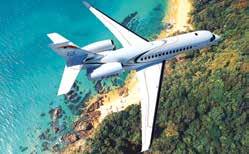
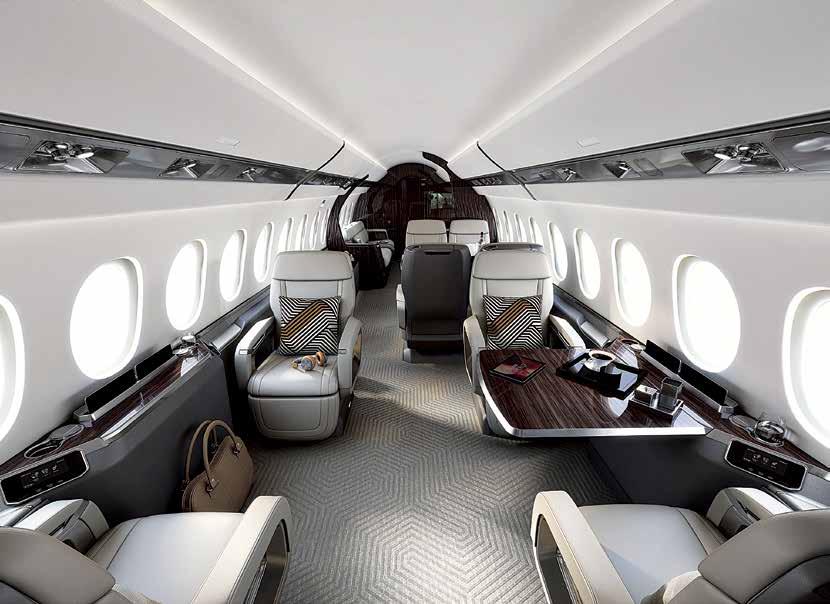
REDEFINING COMFORT IN BUSINESS JETS
Leading Bizjet manufacturers are transforming business travel with the use of cutting-edge technologies to deliver the ultimate travel experience Top of Form
By ROHIT GOEL
18 ISSUE 4 • 2024 www.sps-aviation.com BUSINESS AVIATION TECHNOLOGY
PHOTOGRAPHS:
THE FALCON 6X SEAMLESSLY INTEGRATES CUTTING-EDGE TECHNOLOGY WITH AN UNPARALLELED CABIN EXPERIENCE INSIDE THE WORLD’S FIRST ULTRA-WIDEBODY JET
DASSAULT AVIATTION
The demands of business travel can be gruelling. Long distances, tight schedules, and cramped quarters can leave even the most seasoned traveller feeling drained. Thankfully, technology and innovation are transforming business jets into luxurious havens, prioritising comfort and productivity for the modern executive.
A FOCUS ON WELLBEING
Gone are the days of cramped seats and limited legroom. Today’s business jets boast ergonomically designed seating that allows for comfortable stretching and relaxation. Advanced lighting systems mimic natural daylight, combating jet lag and promoting a sense of well-being.
Luxury extends beyond physical comfort. Aircraft manufacturers offer a range of customisable design options, allowing you to create a cabin environment that reflects your personal preferences. Imagine rich leathers, polished wood veneers, and ample natural light streaming through oversized windows. Soothing colour palettes and plush materials create a tranquil environment, while advanced lighting systems allow you to adjust the mood for work or relaxation. Larger jets even offer amenities like showers, fullservice galleys, and private bedrooms, transforming your journey into a luxurious escape. This is your workspace, your relaxation zone, and ultimately, your home away from home.
Business continuity is paramount. High-speed internet connectivity ensures you can stay connected with colleagues, conduct virtual meetings, and finalise deals – all from the comfort of your private jet. Advanced entertainment systems with high-definition monitors, surround sound, and diverse media options cater to your downtime needs. Cabin management systems put you in control, allowing you to adjust lighting, temperature, and entertainment options directly from your seat.
are leveraging technology to offer the ultimate flying experience to their travellers.
DASSAULT FALCON 6X – WORLD’S FIRST ULTRA-WIDEBODY JET
The Falcon 6X breaks the mould of traditional business jets. This meticulously designed aircraft boasts the title of the world’s first ultra-widebody jet, offering an unparalleled cabin experience. Imagine a space that transcends mere transportation; a sanctuary of comfort, privacy, and productivity that allows you to work, relax, and arrive feeling refreshed.
Dassault prioritises passenger well-being with a meticulously designed cabin environment. Thirty extra-large windows and a unique skylight bathe the interior in natural light, offering breathtaking panoramic views and a true connection to the world below. Advanced air filtration systems ensure hospital-grade air quality, ten times better than industry standards, while noise-cancelling technology creates a peaceful haven. Mood lighting allows you to adjust the cabin ambiance to combat jet lag and promote restful sleep.
The Falcon 6X seamlessly integrates cutting-edge technology to keep you connected and productive throughout your journey. Dassault’s innovative cabin management system allows passengers to control the environment and access entertainment options directly from their personal devices. FalconConnect, a high-speed broadband solution, provides uninterrupted internet access, ensuring you can stay informed, connected, and in control during even the longest flights.
Today’s business jets boast ergonomically designed seating that allows for comfortable stretching and relaxation, combatting jet lag and promoting a sense of well-being
While comfort is crucial, safety remains the top priority. Business jets are equipped with cutting-edge technology to enhance situational awareness for pilots, ensuring a smooth and secure journey. Head-up displays and enhanced vision systems provide pilots with critical information, while a focus on aerodynamics through streamlined designs and lightweight materials contributes to fuel efficiency and overall performance. Advanced avionics, weather radar systems, and fly-by-wire controls contribute to a safe and comfortable flight experience.
The ideal business jet depends on your travel requirements. For shorter trips with smaller groups, light jets offer a practical solution. Midsize jets provide a balance between comfort and range, suitable for groups of up to eight passengers on flights lasting up to five hours. For extended journeys and larger teams, heavy jets deliver unparalleled comfort and intercontinental range. For those seeking the pinnacle of luxury travel, wide-body VIP jets offer the ultimate in space and comfort. These meticulously designed flying palaces feature multiple cabins, conference rooms, bedrooms with ensuite bathrooms, and entertainment areas – effectively replicating the comforts of home at 30,000 feet. Here we look at some of the most popular business jets in their category and how they
Safety remains paramount. The Falcon 6X features Dassault’s awardwinning EASy IV avionics suite, boasting the latest generation of displays, processing power, and safety features. An advanced Digital Flight Control System (DFCS) ensures smooth and precise handling, while the innovative FalconEye Combined Vision System offers pilots unmatched situational awareness in all weather conditions.
The Falcon 6X is not just about luxury; it’s about responsible travel. Pratt & Whitney PW812D engines deliver exceptional performance and efficiency, with double-digit improvements in fuel burn, emissions, and noise over previous generations. The 6X boasts an impressive range of 5,500 nautical miles, allowing you to connect distant cities like London and Singapore non-stop. Additionally, the aircraft’s design allows for exceptional short-field performance, opening up access to a wider range of airports.
Dassault understands that one size doesn’t fit all. The Falcon 6X offers an unparalleled level of cabin customisation, allowing you to tailor the space to perfectly suit your needs and preferences. Imagine a versatile environment that transforms to accommodate business meetings, family gatherings, or a restful retreat. Work with Dassault’s design team to create a personalised haven that reflects your unique style and travel preferences.
The Falcon 6X is the culmination of Dassault’s rich heritage in business jet innovation. For over 70 years, Dassault has pushed the boundaries of what’s possible, pioneering advancements in aerodynamics, materials science, and avion-
19 ISSUE 4 • 2024 www.sps-aviation.com BUSINESS AVIATION TECHNOLOGY
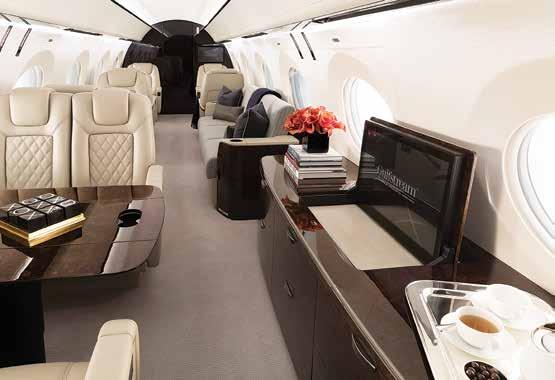
ics. When you choose the Falcon 6X, you’re not just acquiring an aircraft; you’re becoming part of Dassault’s legacy of excellence and unwavering commitment to the future of flight.
GULFSTREAM G500: USHERING IN AN ULTRAMODERN ERA OF FLIGHT
The Gulfstream G500 transcends the boundaries of a traditional business jet. It’s a revolution in design, a champion of efficiency, and a pilot’s haven brimming with safety features.
The Gulfstream G500 throws out the rulebook and leverages technology to redefine the future of business aviation. This meticulously crafted aircraft boasts a “clean-sheet” design, unburdened by legacy limitations. This allows Gulfstream to incorporate the latest advancements in aerodynamics, materials science, and avionics, resulting in an aircraft that’s not just new, but truly groundbreaking.
Time is a precious commodity, and the G500 understands that. Thanks to class-leading fuel efficiency, the G500 boasts a high-speed cruise of Mach 0.90. This translates to shorter flight times, allowing you to reach your destination sooner and maximise your productivity. The benefits extend beyond just time savings. Reduced fuel consumption translates to lower operating costs and less environmental impact.
The G500’s cockpit isn’t just a workplace; it’s a symphony of safety and intuitive design. The centre piece is the revolutionary Gulfstream Symmetry Flight Deck. This marvel features active control sidesticks that provide pilots with unparalleled visual and tactile feedback, enhancing situational awareness and ensuring a smoother, more precise flying experience. Ten strategically placed touchscreen displays keep vital information at your fingertips, while Phase-of-Flight intelligence anticipates your needs and displays relevant data, streamlining operations and minimising pilot workload.
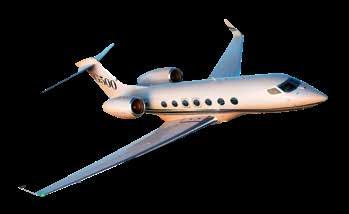
TECHNOLOGY PLAYS A VITAL ROLE IN THE GULFSTREAM G500 CREATING AN UNPARALLELED PASSENGER EXPERIENCE WITH THE QUIETEST CABIN IN BUSINESS AVIATION, 100 PER CENT FRESH AIR CIRCULATION AND AN ULTRA LOW CABIN ALTITUDE

Technology plays a vital role not just in the G500’s flight characteristics, but also in creating an unparalleled passenger experience. Imagine a cabin that’s not just spacious and luxurious, but also designed to combat fatigue and promote wellbeing. The G500 boasts the title of the quietest cabin in business aviation, thanks to advanced noise-cancellation technology. Additionally, 100 per cent fresh air circulation and an ultralow cabin altitude ensure you arrive feeling refreshed and alert, ready to tackle your next business endeavour.
The G500 redefines the concept of in-flight views. Fourteen panoramic oval windows, the largest in business aviation, flood the cabin with natural light, offering breathtaking vistas and a true connection to the world below. Gulfstream’s commitment to innovation extends beyond just passenger comfort. The G500 is a champion of sustainability. A powerful combination of high-thrust engines, an aerodynamic wing design, and advanced avionics results in an aircraft that’s 33 per cent more fuel-efficient than its predecessors. This focus on environmental responsibility underscores Gulfstream’s dedication to a greener future of flight.
The Gulfstream G500 is a testament to Gulfstream’s vision for the future of business aviation. By seamlessly blending cutting-edge technology with unparalleled passenger comfort and a commitment to sustainability, the G500 ushers in a new era of flight, ensuring you arrive not just faster, but also feeling refreshed and ready to take on the world.
BOMBARDIER GLOBAL 5500: REDEFINING COMFORT THROUGH TECHNOLOGICAL INNOVATION
Imagine an aircraft cabin so technologically advanced that it transforms the very concept of comfort. The Bombardier Global 5500 achieves this feat by seamlessly blending cuttingedge design with unparalleled passenger well-being. Let’s
20 ISSUE 4 • 2024 www.sps-aviation.com BUSINESS AVIATION TECHNOLOGY
PHOTOGRAPHS:
GULFSTREAM
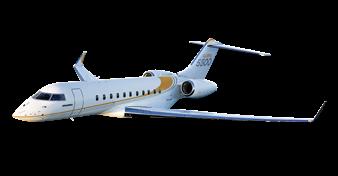
BOMBARDIER
GLOBAL 5500 IS A TESTAMENT TO TECHNOLOGICAL INNOVATION, SEAMLESSLY INTEGRATING CUTTING-EDGE DESIGN WITH PASSENGER COMFORT, OFFERING A SANCTUARY OF COMFORT, CONNECTIVITY, AND EFFORTLESS TRAVEL
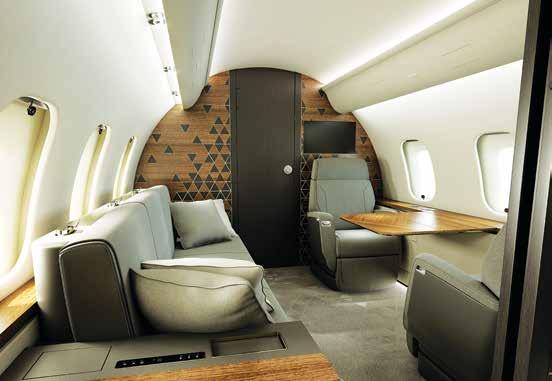
embark on a journey to explore how Bombardier leverages technology to elevate your in-flight experience to new heights.
Step inside the Global 5500 and be greeted by the industry’s widest cabin, a testament to Bombardier’s commitment to spaciousness. This expansive environment is cleverly divided into three distinct living areas, each meticulously designed to cater to your specific needs. The Nuage seat, a revolutionary innovation by Bombardier, takes centre stage. This ergonomic marvel goes beyond just reclining; its unique design allows for a deep recline position, cradling you in unparalleled comfort for long journeys. But the Nuage seat’s brilliance lies in its versatility. When work beckons, the Club Suite transforms into a productive haven with concealed side tables and ample storage, all within reach thanks to intuitive in-seat technology.
Bombardier doesn’t stop at physical comfort. They understand the importance of staying connected and entertained during a flight. The Global 5500 boasts the first-ever 4K enabled cabin, allowing you to indulge in ultra-high-definition entertainment on a whim. Industry-leading Ka-band highspeed internet connectivity ensures you’re never out of touch, whether you need to catch up on emails, participate in video conferences, or stream your favourite shows. Bombardier’s cabin management system puts you in control, allowing you to personalise the lighting, temperature, and entertainment options with a simple touch.
The Global 5500’s technological prowess extends far beyond the passenger cabin. The Bombardier Vision flight deck prioritises pilot comfort and situational awareness. This industry-leading marvel features a comprehensive avionics suite, but the true game-changer is the world’s first combined vision system. Imagine having a clear picture of the runway even in challenging weather conditions. This innovative tech-
nology seamlessly merges enhanced and synthetic vision imagery, giving pilots an unparalleled view and ensuring the smoothest possible landing for your ultimate comfort.
Technology is also at the heart of the Global 5500’s impressive performance. Purpose-built Rolls-Royce Pearl engines, powered by cutting-edge engineering, propel the aircraft to speeds of Mach 0.90. This translates to arriving at your destination ahead of schedule, maximising your precious time. But speed is just one facet of the Global 5500’s prowess. With a class-leading range of 5,900 nautical miles, you can connect distant cities like London and Singapore non-stop. Bombardier’s innovative Smooth Flĕx Wing technology harnesses the power of aerodynamics to deliver an exceptionally smooth ride, minimising turbulence for a tranquil journey.
The Bombardier Global 5500 is a testament to Bombardier’s commitment to technological innovation. By seamlessly integrating cutting-edge design with passenger comfort, the Global 5500 redefines the very concept of business travel, offering you a sanctuary of comfort, connectivity, and effortless travel.
A SEAMLESS TRAVEL EXPERIENCE:
Leading manufacturers go beyond the flight itself. Global maintenance networks ensure rapid access to technical assistance, spare parts, and training anywhere in the world. Completion centres offer customisation options to tailor the jet to your specific needs and preferences, creating a truly personalised travel experience.
Business travel no longer has to be a chore. With a focus on comfort, technology, and personalisation, modern jets offer a luxurious and productive environment that allows you to arrive at your destination feeling refreshed and ready to take on the world. SP
21 ISSUE 4 • 2024 www.sps-aviation.com BUSINESS AVIATION TECHNOLOGY
PHOTOGRAPHS: BOMBARDIER
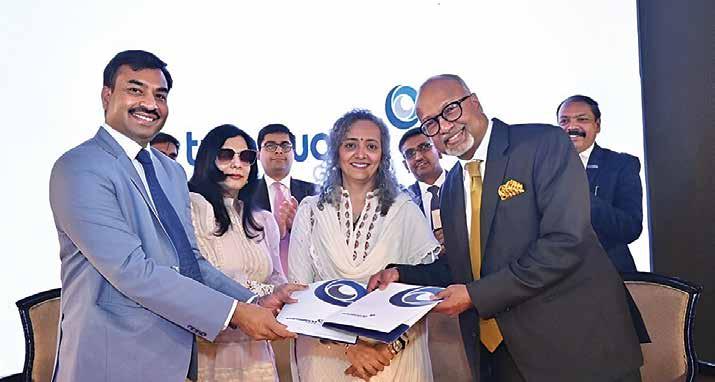
SIRIUS INDIA AIRLINES HAS PARTNERED WITH AIRAVAT AVIATION, A LUXURY AIR TRAVEL BRAND OWNED BY THE DUBAI-BASED TRANSWORLD GROUP, TO INTRODUCE PREMIUM PRIVATE CHARTER SERVICES
“INDIA’S CHARTER SEGMENT IS UNDER-SERVED” — ARUN KASHYAP
An Unserved private charter segment propels MRO veteran Arun Kashyap to start off on his own new venture Sirius India Airlines by partnering with a UAE-based conglomerate Airavat Aviation.
The Q&A below is an attempt to give a brief glimpse into the life of Arun Kashyap, the reasons behind the major switch from MRO to charters and his reasons for diving into the interesting world of business aviation. Speaking to Swaati Ketkar for SP’s Aviation in an exclusive interview, Arun Kashyap tells us about his plans for the new venture, his thoughts on fractional ownership and the post-pandemic luxury and business aviation segment in India. Read on…
Swaati Ketkar (Swaati): First of all, congratulations on the launch of a new charter company, Sirius India Airlines. What attracted you to the charter segment of aviation?
Arun Kashyap (Arun): Thanks for your wishes! The charter segment of aviation offers unique opportunities for personalised, flexible travel experiences. And most importantly the sector is under-served; and which was a key factor in our decision to launch Sirius India Airlines in this segment.
Swaati: The switch from MRO to Charter came as a surprise to many. Can you tell our readers your thoughts behind this switch?
Arun: While I may not have a lot of specifics to share right now, it’s crucial to understand that we have not stopped our MRO business. In reality, our MRO services complement and bolster our Charter business.
22 ISSUE 4 • 2024 www.sps-aviation.com BUSINESS AVIATION INTERVIEW
1 st & EXCLUSIVE
PHOTOGRAPHS: SIRIUS INDIA AIRLINES
Swaati: Which are the routes you are planning to explore initially i.e – at the launch phase of operations?
Arun: As a charter business, we don’t have fixed route planning. We’re prepared to cater to client demands anywhere in India primarily. With our partners, Airawat, (a Transworld Group company), having the capacity for international charter travels, we’re certainly looking to explore that market as well.
Swaati: You initially plan to start operations with a Hawker 4000 aircraft and with plans to add another three aircraft this financial year. What is your aircraft of choice for fleet expansion and why?

Arun: Initially, our operations will be solely with the Hawker 4000 aircraft. Our plan is to incorporate two additional aircraft between September and February this year. Introducing another class or make of aircraft could potentially raise operational and maintenance costs. We are also evaluating other aircraft types in all segments to cater our future growth.
Swaati: Your thoughts on fractional ownership in private charter. How will it give a much-needed boost to the segment?
Arun: Fractional ownership in private charter is a promising avenue that can revolutionise the segment. It allows individuals and businesses to enjoy the benefits of private air travel without the burdens of full ownership. This model can significantly boost accessibility and affordability in the private charter sector and will enhance the demand of business jet in country.
Swaati: Will you consider operating under RCS-UDAN routes? How relevant do you find the RCS-UDAN to BA and GA industry in India?
Arun: We are not considering operating under RCS-UDAN routes in this segment of business. The RCS-UDAN scheme is not so relevant to Business Aviation in India. For fostering growth
and accessibility, RCS is more relevant in commercial aviation with different type of aircraft fleet. We don’t fall into the same with Business Jet.
Swaati: Luxury and business charter segment is on a roll in India, especially post-pandemic. Your views?
Arun: The luxury and business charter segment in India has seen significant growth, especially post-pandemic. This trend reflects the increasing demand for personalised, safe, and efficient travel options. We are excited to contribute to this thriving market and provide unparalleled service to our clients. However, the private charter segment in India is underserved and holds immense potential for growth. While competition is increasing, there is still ample room for new players to enter the market and offer innovative services. Positives include a growing affluent class, increasing business travel needs, and a desire for exclusive travel experiences. However, challenges such as infrastructure development and regulatory complexities need to be addressed, with collaboration between industry and authorities.
Swaati: Any words of advice to potential investors planning to venture into private charter market in India?
Arun: As a new business entity in this sector, speaking from that limited experience wouldn’t be appropriate. However, drawing from our extensive years in this industry, we have some advice for new entrants. To potential investors eyeing the private charter market in India, I would suggest thorough market research and a strong emphasis on customer-centric services. Understanding the diverse needs of travellers and delivering customised, high-quality experiences will be pivotal for success. Furthermore, staying updated on regulatory shifts, Operational challenges and investing in infrastructure will be essential for sustainable growth in this dynamic sector. SP
ARUN KASHYAP — A BRIEF INTRODUCTION
Arun Kashyap, Promoter and CEO of Sirius India Airlines, is an aviation veteran with a Master’s in Air Transport Management from City University, London, boasting over 25 years of global experience. He’s held key roles at Jet Airways, Oman Air, Flydubai, Air India, and SpiceJet where he spearheaded major initiatives.
Kashyap got his first commercial break with Jet Airways as Duty Officer in 1999. After spending a decade in Jet Airways fulfilling various operational roles like Shift In charge, Aircraft Maintenance, Modification, Defect Rectification and Analysis, AOG recovery, Instructor and Avionics Licence, he joined flydubai in 2009 as maintenance controller and within the next three years he quickly jumped ranks to become manager of maintenance control. After this there was no looking back. Post flydubai Arun Kashyap got a break with SpiceJet as General Manager- Fleet Management and quickly rose to the ranks of Executive VP- Engineering & Head of Allied Aviation Business and later as Chief program & Transformation officer with SpiceJet.
Post SpiceJet came a turning point in Arun Kashyap’s career as he got his big break with Air India, as the airline was undergoing major transformation under Tata belt, Arun Kashyap was a part of the team that placed historic order of 470 aircraft. After spending a year at Air India and being a part of the revolutionary journey of the airline, Kashyap had his home-coming with SpiceJet, this time as the Chief Operations Officer.
Kashyap has managed annual budgets exceeding $1 billion for 100+ aircraft fleet, leading strategic acquisitions and contract negotiations. A seasoned CXO leader, he’s driven cost reduction, restructuring, and technology integration, pivotal in SpiceJet’s turnaround in 2014 and navigating the COVID crisis. Arun’s diverse expertise includes establishing MRO facilities, training setups, seaplane operations, air ambulance services, Cargo Airline set up and COVID testing centers.
Arun Kashyap attributes his success to SpiceJet MD Ajay Singh for bringing out the best in him and for giving his valuable mentorship throughout his career. SP
23 ISSUE 4 • 2024 www.sps-aviation.com BUSINESS AVIATION INTERVIEW
ARUN KASHYAP, PROMOTER AND CEO, SIRIUS INDIA AIRLINES
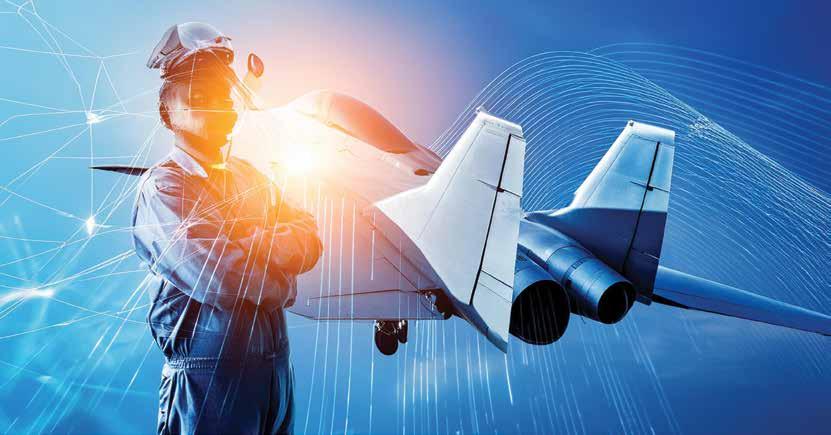
THE IAF CENTRE OF EXCELLENCE FOR ARTIFICIAL INTELLIGENCE (COEAI) IS SLATED TO WORK ON CUTTING-EDGE APPLICATIONS, TRANSFORMING CORE AREAS SUCH AS SUPPLY LOGISTICS, INTELLIGENCE GATHERING, SENSORS, AND DECISION SUPPORT SYSTEMS
INDIAN AIR FORCE PUSHING BOUNDARIES
With a Big Data Analytics and Al Platform at the heart of Al Centre, Indian Air Force (IAF) is adopting some of the groundbreaking AI applications and integration in its platforms and systems. AI is going to redefine air combat and the scope of C4I and IAF is embracing the various decision support systems and driving the aerospace industry.
By MANISH KUMAR JHA
Artificial
Intelligence
(AI) has been making significant strides in the aerospace industry, including its applications in the Indian Air Force (IAF). The groundbreaking initiative of establishing the IAF Centre of Excellence for Artificial Intelligence (CoEAI) under the aegis of UDAAN (Unit for Digitisation, Automation, Artificial Intelligence and Application Networking) at Air Force Station Rajokri, is slated to be working on cuttingedge applications.
The IAF is transforming its core areas by infusing AI into supply logistics, intelligence gathering, sensors, and Decision Support Systems through the application commonly known as the Internet of Battlefield Things (IoBT).
A BIG DATA ANALYTICS AND AI PLATFORM
The IAF has commissioned a Big Data Analytics and Al Platform in the IAF’s Al Centre. The Centre will drive AI integration in all
24 ISSUE 4 • 2024 www.sps-aviation.com TECHNOLOGY IAF
ILLUSTRATION: SP’S TEAM
aspects of Analytics, Machine Learning, Natural Language Processing, Neural Networks and Deep Learning algorithms.
According to the senior IAF official, the scope of the AI centre is critical in analysing high-end computing requirements which are to be driven by the next-generation Graphical Processing unit-powered servers.
Recently, on AI in aerospace and its radical applications, Air Marshal Ashutosh Dixit, Deputy Chief of the Air Staff explained that the IAF has taken steps to integrate Al-based technologies in its war-fighting processes. The steps will further embed aerospace into Industry 4.0. He reiterated that the AI COE with highend compute and big data storage capabilities, coupled with fullspectrum Al software suites, would substantially enhance the operational capability of IAF.
The aerospace industry in its various upgradation programmes has been developing Al-based applications in conjunction with various Public Sector Undertakings (PSUs), MSMEs and leading academia.
Surveillance and Reconnaissance. AI-powered systems can analyse vast amounts of sensor data from satellites, UAVs, and other platforms to detect, track, and identify potential threats. These systems enable the IAF to monitor airspace and ground activities more effectively, enhancing situational awareness and intelligence gathering.
One of the key areas in intelligence where the IAF has taken the lead is an application based on a common structure called-- Comprehensive Electronic Order of Battle (CEOB). Here, the AI infusion captures electronic intelligence gathered by it as well as from other intelligence agencies and integrates them into a single platform (CEOB).
Mission Planning and Decision Support. IAF has been focusing on AIbased machine systems for collaborating and creating modules for machine planning, radar, and sub-systems. These are highly collaborative with several military startups building on this under the overall aegis of IAF.
designed and built on the distributed framework of Hadoop and supports “intelligent” and informed solutions. Importantly, this framework has been used widely for providing Decision Support for Deployment, Transport Allocation, Convoy composition and scheduling and Coastal Surveillance.
Already, algorithms are deeply entrenched in flying planes in various functional autonomous modes. Now, AI is more about trusting to fly planes on its own and more importantly, can AI be fully trusted by the pilots. For example, in operational and combat situations, the AI’s role in the OODA loop—the decision cycle of orient, observe, decide, and act.
How do we connect the complexity of AI with the OODA loop? In a well-documented dogfight between the US fighter aircraft F-86 against the Russian MiG-15, the OODA loop played a decisive role. The fact that the American F-86 won over the MiG-15 is because US pilots took a much shorter OODA loop in the observing and acting phase of combat operation. The data matrix simply analysed that the F-86 had a much wider field of vision and easier hydraulic controls that allowed them to outrun the OODA loops of Russian pilots.
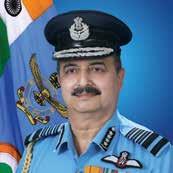
“The use of tools of analytics and software and artificial intelligence need to be used to assess pilots instead of assessing them based on one sortie”
— Air Chief Marshal
V.R. Chaudhari
How AI is being leveraged by the advanced military worldwide? One of the coveted areas is the computer vision capability of artificial intelligence for activities like detecting and hunting down submarines, detecting an enemy intrusion, or decoding messages using machine learning abilities.
This is based on the latest development in the core of AIbased Decision Support Systems (DSS) which can fundamentally address such complex environments and analyse the sensory data through processors. It is pertinent to note thatthe IAF has been leveraging DSS and building a framework which is also a priority and foundational project led by the Defence Research and Development Organisation (DRDO).
The framework is part of the latest breakthroughs in technology based on Algorithms like criteria decision-making (MCDM), Swarm Algorithms, Game theoretic approaches towards resource allocation, search algorithms etc. It is
So, the historical fights define the role of AI which can process vast information in such a short time frame which is impossible to calculate and analyse in the usual case of decisionmaking in high-temp aerial combat. Here AI can further define and reduce the key elements like the OODA loop in a high-flying supersonic combat jet.
Additionally, AI-based software assists in mission planning by analysing vast amounts of data to identify optimal routes, targets, and strategies. It also provides decision support to pilots and commanders during missions by analysing sensor data, assessing threats, and recommending actions.
Flight Control Systems. AI algorithms are used in advanced flight control systems to optimise aircraft performance, improve fuel efficiency, and enhance safety. These systems can adapt to changing flight conditions in real time, making split-second decisions to ensure the safety of the aircraft and its crew.
AI FOR AUTONOMOUS VEHICLE
It is the autonomous areas — Unmanned Aerial Vehicles (UAVs)— where AI is so radically influencing military applications. The air forces are using and improving the AI applications in UAVs which are spreading across an impressive variety of domains, including ISR (intelligence, surveillance and reconnaissance) and targeting with minimal human intervention.
Moreover, AI is also playing a major role in developing anticombat drone solutions. How can a technology—AI-based-- disable a hostile drone while leaving a friendly drone a few feet distant in the clusters unharmed? That is where a US-based startup Epirus has succeeded in its prototype ‘Leonidas’, which took down a hostile drone while distancing itself from
25 ISSUE 4 • 2024 www.sps-aviation.com TECHNOLOGY IAF
the friendly drones in complex clusters. The groundbreaking achievement was based on the AI algorithms and super-dense Gallium Nitride power amplifiers, where Leonidas converted direct energy to precise frequencies which can take out both large fixed-wing drones and small quadcopters.
The IAF unmanned projects – Rustom–II UAV and Ghatak UCAV– are using such Intelligent Unmanned Systems which are based on Computer Vision Processing and Artificial Intelligence. For example, DRDO’s Ghatak UCAV, a stealth unmanned combat aerial vehicle (UCAV) initiated under the programme–AURA (Autonomous Unmanned Research Aircraft) is based on AI-enabled systems. The development will be critical in terms of target detection and use of Lethal Autonomous Weapon Systems (LAWS).
How important the AI initiative is in the IAF’s perspective plan is clear on the policy thrust on developing indigenous UAV projects which rests largely on AI applications.
Predictive Maintenance. AI algorithms analyse sensor data from aircraft components to predict potential failures before they occur. This allows maintenance crews to perform proactive maintenance, reducing downtime and increasing the reliability of aircraft.
Training and Simulation. AI-powered simulators provide realistic training environments for pilots and ground crew, allowing them to practice various scenarios in a safe and controlled setting. These simulators can replicate complex flight conditions and scenarios, helping to improve aircrews’ skills and decision-making abilities. The IAF has successfully integrated the Virtual Reality (VR) platforms for the fighter pilots from the training stage to the operational areas. According to the IAF senior official, the indigenisation for VR simulation has been a success story, which has not only been cost-effective but has significantly reduced the high expenses that would have been otherwise incurred on flying hours using real aircraft.
Obviously, by integrating AI and VR systems into training and operations, the IAF aims to achieve higher levels of efficiency as the Chief of the Air Staff, Air Chief Marshal V.R. Chaudhari highlighted: “The use of tools of analytics and software and artificial intelligence need to be used to assess pilots instead of assessing them based on one sortie.”
Air Force Chief has been a key proponent of AI. In his observation, he pointed out: “We have every move recorded and there is a need to develop AI-based software to analyse the metadata instead of assessment based on the subjective opinion of trainers.” Chaudhari further explained, “We are now in the phase of infusion of tech technology and interconnected platforms and components including AI, machine learning
and technology and there was a need to recognise the value of new technology and need to assimilate the knowledge.”
Cybersecurity. AI detects and mitigates cybersecurity threats to aircraft systems and networks. AI algorithms can analyse network traffic, identify anomalous behaviour, and respond to cyber-attacks in real time, enhancing the resilience of aerospace systems against cyber threats. IAF has taken the lead in building AI-based mechanisms under the Defence Cyber Agency (DCyA) of the Indian Armed Forces. The IAF’s recent focus on the Op network is in the form of the Air Force Network (AFNET) is based on AI-based software which is also constantly upgraded. It boosted sensors Radars with Data-link based on Satellite by infusing AI-enabled data processing-real time.
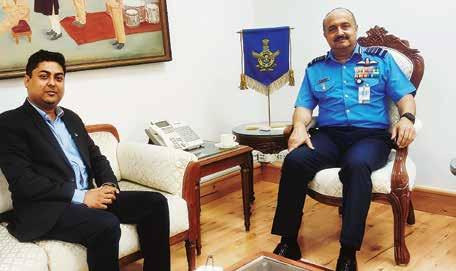
Strategic Planning and Analysis. AI-based analytics tools assist Air Force planners and strategists in analysing vast amounts of data to make informed decisions about force structure, resource allocation, and operational planning. These tools can identify trends, patterns, and potential risks, helping to optimise Air Force operations.
AI is revolutionising unmanned aerial vehicle (UAV) applications, including ISR, targeting, and antidrone solutions, enhancing military capabilities in reconnaissance and combat
Logistics and Supply Chain Management. AI algorithms optimise logistics and supply chain operations by analysing data on inventory levels, transportation routes, and maintenance requirements. By improving the efficiency of logistics processes, the IAF can ensure timely delivery of equipment, spare parts, and supplies to support its missions.
In the context of IAF, AI is likely to be integrated into various platforms and systems to enhance operational capabilities, improve situational awareness, and increase the effectiveness of air operations. R&D efforts are likely underway to explore new applications of AI in aerospace, intending to maintain India’s air superiority and ensure the safety and security of its airspace. SP
26 ISSUE 4 • 2024 www.sps-aviation.com TECHNOLOGY IAF
PHOTOGRAPH: INDIAN AIR FORCE
CHIEF OF THE AIR STAFF, AIR CHIEF MARSHAL V.R. CHAUDHARI WITH AUTHOR MANISH JHA
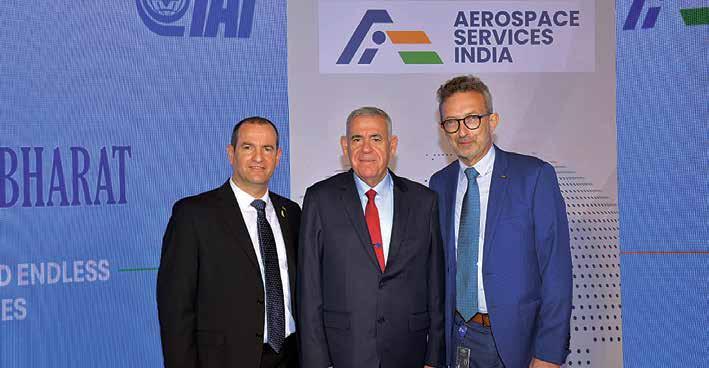
IAI LAUNCHES AEROSPACE SERVICES INDIA
Israel Aerospace Industries (IAI) reiterates its 3-decades’ long commitment with the launch of AeroSpace Services India (ASI) in New Delhi
By NEETU DHULIA
Israel Aerospace Industries (IAI) has expanded its footprint in India with the launch of AeroSpace Services India (ASI) in New Delhi, a move that underscores its commitment to strengthening ties with the Indian defence sector. The inauguration of ASI, aligning with India’s ‘Atmanirbhar Bharat’ initiative for self-reliance in defence manufacturing, marks a significant milestone in the partnership between IAI and India’s Defence Research and Development Organisation (DRDO).
As the sole authorised OEM’s Technical Representative for the Medium Range Surface-to-Air Missile (MRSAM) system, ASI operates in Indian Rupees, streamlining transactions for defence systems jointly developed by IAI and DRDO. Boaz Levy, President and CEO of IAI, expressed pride in ASI’s role in advancing India’s self-reliance goals, under the leadership of CEO Danny Lauber and a predominantly Indian workforce. With strategically located branches across the subcontinent, ASI aims for
comprehensive service coverage and prompt customer support.
The event saw the presence of Noar Gilon, Ambassador of Israel to India, highlighting the evolution of strategic relations between the two nations, particularly in defence cooperation, facilitated by IAI’s involvement. Vice Admiral B. Sivakumar, the Chief Guest, envisioned efficient repair processes and emphasized the importance of product support, praising the reliability of MR-systems in challenging environments.
The occasion also witnessed the participation of senior officials from DRDO, BEL, BDL, and the industry, reflecting the collaborative efforts driving advancements in defence technology and fostering enduring partnerships between India and Israel.
During the event, Jayant Baranwal, Editor-In-Chief of SP Guide Publications, along with Neetu Dhulia, engaged in a discussion with Oded Jacobowitz, Chairman of the Board of AeroSpace Services India (ASI):
27 ISSUE 4 • 2024 www.sps-aviation.com INDUSTRY IAI
(LEFT TO RIGHT) ODED JACOBOWITZ, CHAIRMAN OF THE BOARD, AEROSPACE SERVICES INDIA (ASI); BOAZ LEVY, PRESIDENT AND CEO, ISRAEL AEROSPACE INDUSTRIES (IAI) AND DANNY LAUBER, CEO, AEROSPACE SERVICES INDIA (ASI)
PHOTOGRAPH: IAI
Jayant Baranwal (Jayant): As the Chairman of ASI’s board, what exactly will be your role? What is the roadmap of ASI and what is the vision behind launching this Indian subsidiary from Israel?
Oded Jacobowitz (Oded): Good question! The establishment of AeroSpace Services India (ASI) marks a significant milestone in strengthening our ties with India and expanding our business operations in the region. Over the past two decades, we have collaborated closely with Indian services, particularly in the field of air defence systems. This new venture signifies a deeper commitment to conducting business directly from India, thereby fostering a stronger connection between Israel and India.
ASI represents more than just a company; it embodies a partnership between our nations. With a workforce comprising predominantly Indian professionals–technicians, engineers, and skilled personnel–ASI reflects our dedication to local talent and expertise. Currently, ASI boasts a team of approximately 50 employees, with only a handful being of Israeli origin.
Looking ahead, we envision numerous opportunities for growth, not only in providing product support within India but also in manufacturing and exporting from the region. Our collaborations extend beyond mere business transactions; we have cultivated robust relationships with both public sector undertakings such as BEL and BDL and private enterprises. Together, we have already embarked on several contractual agreements.
The systems we are involved in have been the result of collaborative efforts between esteemed organisations like DRDO, IAI, BEL, and BDL. This collective endeavour underscores the synergy and cohesion among various stakeholders, paving the way for a successful trajectory for ASI and its endeavours.
Jayant: You refer to manufacturing facility. Would it be for India and for the world, too?
Oded: Exactly! Our vision for ASI is expansive, aiming to position it alongside other Indian companies with the capability to export globally from India. However, it’s essential to recognise that ASI is still in its early stages, akin to a growing child maturing into adulthood. Therefore, our approach is sequential, focusing on developing the necessary capabilities over time.
At present, we boast a robust facility capable of supporting existing contracts effectively. Looking ahead, we are keenly focused on future opportunities. For instance, as highlighted in the speech by Admiral B. Sivakumar, turnaround time and service efficiency are paramount. Having a local presence in India ensures swift response times in case of failures, thereby facilitating prompt repairs. Moreover, leveraging local resources means cost-effectiveness, as production and maintenance are carried out by skilled Indian professionals. This not only ensures competitiveness but also contributes to the local economy. In essence, our strategy revolves around gradual growth and strategic utilisation of local capabilities to achieve long-term success.
Jayant: When you say facilities, can you give us some details on these facilities and the kind of capabilities they possess, as of now in India?
Oded: Currently, we have established partnerships with Indian companies possessing the requisite capabilities, such as ADSL in Hyderabad, SASMOS, DCX, among others. Moreover, we are in the process of constructing facilities where we perceive advantages in doing so independently. However, should there be unique expertise or cutting-edge technology required, we are keen on leveraging Indian capabilities. India’s infrastructure, from my experience, is exceptional, facilitating swift project execution. For instance, the recent construction of our office, which typically
PROFILE: ODED JACOBOWITZ, CHAIRMAN OF THE BOARD, AEROSPACE SERVICES INDIA (ASI)

Oded Jacobowitz has been at the forefront of ASI’s leadership as the Chairman of the Board of Directors since the company’s inception. With a career spanning over 3 decades, Jacobowitz has been a pivotal figure in the Israeli aerospace industry since 2018. He initially served as the Director of LandBased Air & Missile Defence Systems at the Defence Factory, later transitioning to the role of Deputy General Manager of Air & Missile Defence Systems in 2022.
His expertise and leadership have been instrumental in spearheading the establishment of maintenance support systems in India, a key initiative undertaken by ASI. Prior to his tenure in the aerospace industry, Oded Jacobowitz enjoyed a distinguished 30-year career in the Israeli Defense Forces (IDF), where he held various positions in the technological array on land, retiring with the rank of Brigadier General. SP
would take an extended duration in Israel, was completed within a few months here. This underscores India’s remarkable technological and infrastructural prowess. We are optimistic about the collaborative potential between AI, ASI, and these capabilities.
Jayant: You are the MRSAM person. Through your eyes, what kind of capabilities this programme has brought to Indian armed forces? Can you elaborate a little bit for us?
Oded: I believe it has revolutionised the landscape here in India. Primarily, we are dealing with a state-of-the-art system. Globally, only a handful of companies–about five or six, to my knowledge–possess the capability to offer a comprehensive system comprising radar, command center, launchers, and missiles. At IAI, we stand out as a single entity equipped with all these capabilities. This advancement enhances the defence capabilities across the Indian armed forces–naval systems, air force, and army–significantly bolstering defence infrastructure for various sites and operational requirements. Recently, there was a noteworthy trial conducted a couple of months ago involving the naval forces. During this trial, our MRSAM system successfully intercepted a supersonic target aimed at a naval vessel, showcasing the effectiveness and reliability of our technology.
Neetu Dhulia: You mentioned about the MRO facility in Gurgaon, is the facility being established solely for the maintenance of MRSAM systems within India, or are you open to servicing similar systems from neighboring countries as well?
Oded: Excellent question! In my vision, we aim to serve not only India but also extend our services globally. As I mentioned, our focus will be on MRSAM, with plans to expand our offerings comprehensively. The first step will be to build it strongly. Our philosophy revolves around building a strong foundation before branching out. So as much as strong the company will be, then we can expand, that is in our vision. Therefore, our vision encompasses not only exporting products but also the services worldwide. As our company grows stronger, we envision expanding beyond India to fulfill our global ambitions. That was a good question! SP
28 ISSUE 4 • 2024 www.sps-aviation.com
INDUSTRY IAI
ODED JACOBOWITZ
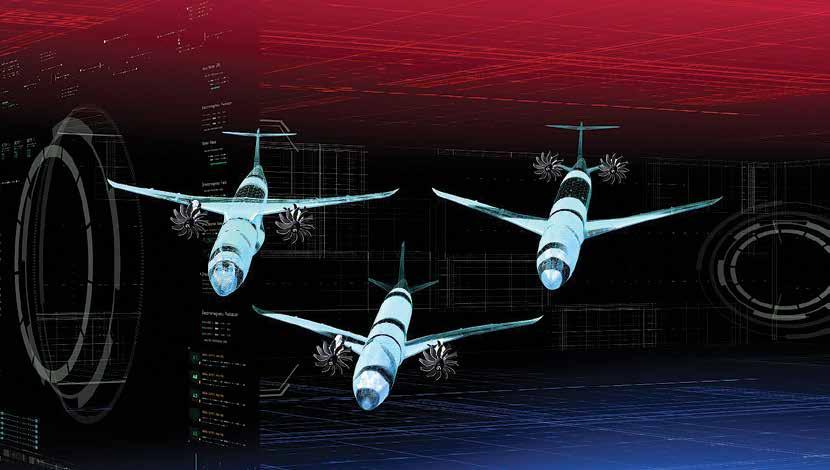
POWERING THE FUTURE
CFM International showcases its RISE next-generation engine architecture that aims to revolutionise engine design, targeting lower noise levels and achieving 100 per cent SAF certification
By SP’S STAFF CORRESPONDENT
CFM International, a global leader in aircraft engine manufacturing, hosted a highly anticipated media briefing on the eve of the Singapore Airshow 2024, to unveil its latest advancements in engine technology for narrowbody aircraft. The event featured comprehensive presentations from key executives including Arjan Hegeman, General Manager of Advanced Technology at GE Aerospace, and Pierre Cottenceau, VP of Engineering, Research & Technology at Safran Aircraft Engines.
CFM International showcased its unparalleled expertise and track record as a world-leading engine supplier, highlighting the exceptional performance and reliability of its CFM56 and LEAP engines. With over 33,000 engines delivered and a backlog of 10,500 LEAP engines, CFM International continues to dominate the market, powering a vast fleet of Airbus A320neo, Boeing 737 MAX, and COMAC C919 family aircraft worldwide. The company reaffirmed its unwavering commitment to sustainability, unveiling groundbreaking advancements aimed
at enhancing efficiency and reducing environmental impact. Noteworthy achievements include a remarkable 40 per cent reduction in fuel consumption since the introduction of the CFM56 engine, underscoring CFM International’s relentless pursuit of efficiency excellence.
THE RISE PROGRAMME
The CFM Revolutionary Innovation for Sustainable Engines (RISE) programme is a groundbreaking initiative, poised to revolutionise the aviation industry. Designed to embody the principles of innovation, sustainability, and efficiency, the RISE programme represents a significant leap forward in engine technology, with a focus on next-generation engine architecture. This initiative aims to revolutionise engine design, targeting lower noise levels and achieving 100 per cent Sustainable Aviation Fuel (SAF) certification. The company is committed to developing cutting-edge technologies that will shape the future of sustainable aviation.
29 ISSUE 4 • 2024 www.sps-aviation.com ENGINES TECHNOLOGY
THE CFM RISE PROGRAMME DEMONSTRATES A RANGE OF NEW, DISRUPTIVE TECHNOLOGIES LIKE OPEN FAN ARCHITECTURE AND HYBRID ELECTRIC CAPABILITY FOR FUTURE ENGINES
PHOTOGRAPH: SAFRAN GROUP
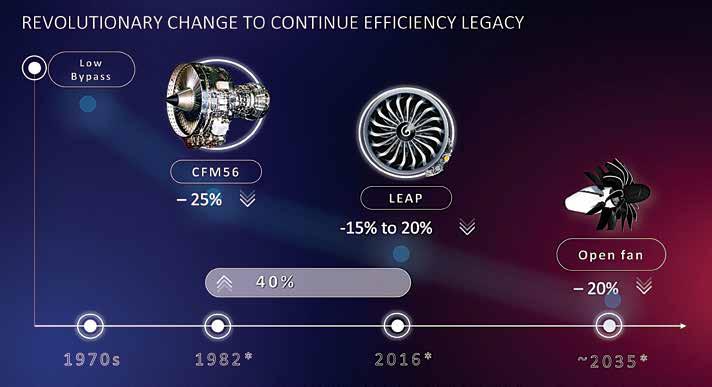
• The Technology Behind RISE: At the core of the RISE programme lies a suite of cutting-edge technologies aimed at redefining the future of aviation. Leveraging next-generation architecture and engineering prowess, RISE engines boast a step-change in efficiency compared to traditional ducted fan engines. One of the most notable advancements is the incorporation of an open fan, low bypass design, which enables a significant reduction in fuel consumption and emissions. CFM International’s RISE engines represent a paradigm shift towards more sustainable and ecofriendly air travel.
• Status of the Programme: The RISE programme has made remarkable progress since its inception, with extensive testing and development efforts underway. CFM International has completed a series of rigorous tests to validate the performance and reliability of RISE engines, including comprehensive aerodynamics and acoustics evaluations. Major milestones, such as fan blade tests, wind tunnel tests, and turbine tests, have been successfully completed, demonstrating the readiness of RISE technologies for ground and flight testing.
• Schedule: CFM International is on track to conduct ground and flight tests of RISE engines throughout the current decade. The programme timeline includes early part-level testing in the mid-2020s, followed by ground tests and flight tests in the 2030s. With a robust conceptual design review completed in 2022, CFM International is well-positioned to accelerate the development and deployment of RISE engines in the coming years.
The RISE programme embodies CFM International’s unwavering commitment to pushing the boundaries of innovation and sustainability in the aviation industry. Through relentless research, development, and collaboration, CFM Interna-
tional aims to pave the way for a greener, more efficient future of air travel.
INVESTMENT IN ALTERNATIVE FUELS
CFM International reiterated its commitment to exploring alternative fuels, with a particular focus on hydrogen propulsion. The company is actively developing next-generation compressor technologies and materials to optimise the performance of hydrogen-powered engines. Through strategic investments and partnerships, CFM International is driving the adoption of sustainable aviation fuels and advancing the industry towards decarbonisation.
Arjan Hegeman, General Manager of Advanced Technology at GE Aerospace, expressed his enthusiasm for CFM International’s groundbreaking initiatives, stating, “CFM International is at the forefront of innovation in the aviation industry. Our commitment to sustainability and efficiency drives us to develop groundbreaking technologies that will shape the future of air travel.”
Pierre Cottenceau, VP of Engineering, Research & Technology at Safran Aircraft Engines, echoed Hegeman’s sentiments, emphasising the importance of collaboration and innovation in realising CFM International’s ambition towards decarbonisation. “We are proud of the progress we have made in realising our ambition towards decarbonisation,” said Cottenceau. “Through collaboration and innovation, we are laying the foundation for a more sustainable aviation industry.”
CFM International is a joint venture between GE Aviation, a division of General Electric Company, and Safran Aircraft Engines, a subsidiary of Safran Group. The company is a leading supplier of commercial aircraft engines, powering more than 600 airline customers worldwide. It’s state-of-the-art testing facilities and collaborative efforts with industry partners underscore its commitment to safety and innovation. SP
30 ISSUE 4 • 2024 www.sps-aviation.com ENGINES TECHNOLOGY
EIS REDUCTION
Since CFM56
PHOTOGRAPH: CFM

AÉROSPATIALE/BAC CONCORDE: RACING THE SUN
Concorde was the only commercial plane that could race the sun. If it departed London at 10 am local time, it reached New York before 10 am local time.
Concorde – the word in French means agreement, harmony or union. It was therefore appropriate that this name, proposed by an eighteen-year-old British youth for the world’s only successful supersonic transport aircraft (SST), was publicly announced by France’s President Charles de Gaulle. The project to build Concorde was one of the most significant examples of Anglo-French technological and business cooperation ever.
Concorde was jointly developed and manufactured by Sud Aviation (later Aérospatiale) and the British Aircraft Corporation (BAC). Construction of the six prototypes began in February 1965. A 1967 advertisement rather optimistically predicted a market for 350 aircraft by 1980. The manufacturers did receive around 100 option orders from many airlines, including two from Air India. However, the development cost was so great – around £1.5 billion against the initial estimate of £70 million – that it could never be recovered. Finally just 20 Concordes were built and only 14 were delivered – 7 each to Air France and British Airways. Both the British and French governments took a substantial financial hit on this account.
Be that as it may, the first flight of the ogival delta-wing Concorde – a technological marvel – took off from Toulouse on March 2, 1969. Concorde subsequently went supersonic on October 1, 1969. The airliner could maintain a supercruise of Mach 2.04 (2,179 km/h) at an altitude of 60,000 feet, from where travellers could simultaneously see the darkness of space and Earth’s curvature. But sonic booms over the ground limited it to transoceanic flights. Constructed out of aluminium, Concorde was a tailless aircraft with a narrow fuselage permitting 4-abreast seating for 92 to 128 passengers. It had a droop nose for better landing visibility. It was powered by four RollsRoyce/Snecma Olympus 593 afterburning turbojets. It was the first airliner to have analogue fly-by-wire flight controls.
Long before it entered commercial service, Concorde facilitated the study of a total solar eclipse. On June 30, 1973, helped by Concorde’s inertial guidance systems, the plane rendezvoused with the eclipse point over North Africa within one second accuracy. Five teams of onboard scientists were enabled to carry out experiments during the totality period artificially extended to 74 minutes. No other transport plane could have done this.
Concorde entered service on January 21, 1976, with Air France from Paris to Rio de Janeiro, and British Airways from London to Bahrain. However, Concorde landings in the USA
were initially banned due to protests over its sonic booms. This not only delayed its launch on the lucrative North Atlantic routes but, more significantly, dissuaded potential purchases from the US airlines. Eventually Concorde services to America received limited permission provided the jet remained in the subsonic regime overland. The first transatlantic flight happened on May 24, 1976, slashing the average flight time between London and New York to about three and a half hours. Concorde was the only commercial plane that could race the sun. When it departed London at 10 am local time, it reached New York before 10 am local time.
But the Concorde dream soon began to unravel. The 197374 stock market crash and the 1973 oil crisis had made many airlines wary about fuel-guzzling passenger planes. New economical wide-body airliners, such as the Boeing 747, had also made subsonic travel significantly more efficient and offered a low-risk option for airlines. And a clear trend towards cheaper airline tickets was emerging – something that Concorde could never aspire to. Concorde consumed four times more fuel than the Boeing 747, which could carry nearly 500 passengers. Environmental advocates argued that Concorde’s emissions would damage the ozone layer. Yet the small fleet of Concordes continued flying for almost three decades, shattering records. In 1996, a British Airways Concorde flew from New York to London in just 2 hours 52 minutes and 59 seconds, which remains the fastest ever transatlantic crossing by a passenger aircraft.
In a strange twist of fate, this sleek, beautiful and ultimately doomed aircraft’s fall from grace was not because of any inherent deficiency or design flaw. On July 25, 2000, an Air France Concorde taking off from Paris struck a piece of metal debris dropped by another airliner on the runway. The thin metal strip punctured one of Concorde’s tyres, sending chunks of rubber flying that ruptured the fuel tank. The left wing burst into flames and the airliner crashed into a building. All 109 people aboard were killed, along with four on the ground. Concorde was immediately grounded and not cleared to return to commercial service for over a year. By then consumer confidence had plunged and the sky-high costs of supersonic jet travel became even more difficult to stomach. Concorde’s final supersonic passenger flight was on October 24, 2003, when it conveyed 100 travellers from New York to London. SP
— JOSEPH NORONHA
HALL OF FAME 31 ISSUE 4 • 2024 www.sps-aviation.com
MILITARY
SUCCESSFUL FIRST FLIGHT OF LCA MK1A

The first Aircraft LA5033 of the Tejas Mk1A Aircraft series took to the skies from HAL facility in Bengaluru. It was a successful sortie with a flying time of 18 minutes. The aircraft was piloted by Chief Test Pilot, Gp Captain K.K. Venugopal (Retd). The Tejas Mk1A will have an advanced electronic radar, warfare, communication systems, additional combat capability and improved maintenance features. The country looks forward to early induction of the Tejas Mk1A by the IAF and more numbers through the three lines of production established at HAL.
DRDO SUCCESSFULLY FLIGHT TESTS VSHORADS

DRDO conducted two successful flight tests of Very Short-Range Air Defence System (VSHORADS) missile on February 28 & 29, 2024 from a ground based portable launcher off the coast of Odisha. These tests were carried out against high speed unmanned aerial targets under different interception scenarios. During all the test flights, the targets were intercepted and destroyed by the missiles, meeting the mission objectives.
VSHORADS is a Man Portable Air Defence System (MANPAD) designed and developed indigenously by Research Centre Imarat (RCI) in collaboration with other DRDO laboratories and Indian Industry Partners. VSHORADAS missile incorporates many novel technologies including miniaturised Reaction Control System (RCS) and integrated avionics which have been successfully proven during the tests.
APPOINTMENTS

EVE ANNOUNCES ANTONIO JOÃO CARMESINI BARCELLOS AS VICE PRESIDENT OF INDUSTRIALISATION
Eve Air Mobility (“Eve”) announced that Antonio João Carmesini Barcellos, current Chairman of the Board and General Director of Embraer Portugal, will be the company’s new Vice President of Industrialisation. With more than 27 years of experience in the aviation industry, Carmesini spent almost eight years as the Director of Manufacturing Engineering at Embraer.

GLOBAL JET CAPITAL APPOINTS MIKE CHRISTIE TO LEAD AMERICAS SALES TEAM
Global Jet Capital has appointed Mike Christie to the position of Head of Sales for the Americas. Most recently, Christie served as Vice President Sales – Western US and Ohio. In his new role, Christie will oversee the company’s sales activities in the United States, Mexico, and Latam. Before joining Global Jet Capital, Mike served in a variety of market-facing sales roles at GE Capital, US Bank, and Huntington National Bank.

BOEING APPOINTS UMA AMULURU AS HUMAN RESOURCES LEADER
Boeing announced Uma Amuluru as the company’s Chief Human Resources Officer and executive vice president, Human Resources, effective April 1. In her new role, Amuluru will be responsible for Boeing’s talent planning, global talent acquisition, learning and development, compensation and benefits, employee and labor relations, and diversity and inclusion initiatives. She will report to Boeing President and CEO David Calhoun and serve on the company’s Executive Council.
DRDO SUCCESSFULLY CONDUCTS MISSION DIVYASTRA
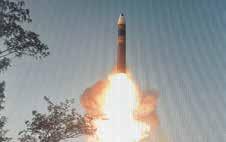
Defence Research and Development Organisation (DRDO) conducted first successful flight test of indigenously developed Agni-5 missile with Multiple Independently Targetable Re-Entry Vehicle (MIRV) technology. The flight test named Mission Divyastra was carried out from Dr APJ Abdul Kalam Island in Odisha. Various Telemetry and radar stations tracked and monitored multiple re-entry vehicles. The Mission accomplished the designed parameters.
AERONAUTICAL DEVELOPMENT AGENCY SIGNS MOU WITH INDIAN AIR FORCE Aeronautical Development Agency
(ADA) has signed an MoU with the Indian Air Force (IAF) for integration of futuristic Weapons and Sensors for LCA Tejas aircraft. In present war scenario, there is a continuous need of upgrading the weapons and sensors suite of the aircraft and towards this, ADA has initiated the know-how transfer for integration of weapons and sensors to Software Development Institute (SDI) of IAF. This will facilitate the IAF to independently carry out sensors, weapon integration and flight testing to enhance the operational capability of Tejas-LCA fighter.
INDUCTION OF HELICOPTER UNIT AT AIR FORCE STATION THANJAVUR
In a recent redeployment of IAF assets, one Helicopter Unit was inducted at Air Force Station Thanjavur on March 19, 2024. Induction of the helicopter unit at Thanjavur would ensure availability of sufficient resources with HQ SAC to enhance operational capabilities as well as meet the peacetime tasks of Search and Rescue, Humanitarian Assistance and Disaster Relief (HADR) and Casualty evacuation. l
32 ISSUE 4 • 2024 www.sps-aviation.com NEWS DIGEST


NOW AVAILABLE Get your copies now: order@spscivilaviationyearbook.com or at +91 97119 33343













C-390 MILLENNIUM

UNBEATABLE COMBINATION




















MISSION-READY WITH THE PORTUGUESE AIR FORCE



We’re delighted to announce the Portuguese Air Force now joins the Brazilian Air Force as a C-390 Millennium operator. The first Portuguese aircraft of the newly formed 506 Squadron is now in service at Beja Air Base, with four more aircraft to be added in the near future. A growing number of countries are choosing the C-390 Millennium (including Hungary, Netherlands, Austria, Czech Republic and South Korea) attracted by its unbeatable combination of technology, speed, performance and multi-mission capabilities. Hungary will take delivery of their first C-390 Millennium in 2024 – another milestone for an incredible aircraft that has already achieved 10,000 flight hours with the Brazilian Air Force.


#C390UnbeatableCombination embraerds.com










